PinotFile: 8.46 November 29, 2011
|
Calera Wine Co.: Stalwart Pinot Icon
the New World, but of Planet Earth. Credit must be extended to its visionary founder, proprietor Josh Jensen. Ironically, today Jensen rarely gets the acclaim that these wines merit.” Robert Parker, Jr., 2003 California has a relatively young Pinot Noir wine history compared to Burgundy, but many of our oldest Pinot Noir producers have shown admirable longevity and pinotphiles are fortunate to still have the opportunity to drink wines from these iconic wineries. In the rush to find the latest, potentially cult Pinot Noir producer, the contributions by these legendary wineries and the consistent excellence of their wines can easily be overlooked. With this issue, I pay homage to the 2008 vintage of Calera Pinot Noir, the thirty-third offering from this isolated winery in the Mt. Harlan appellation of San Benito County. The first vineyards were planted at Calera in 1975, the first wine released from purchased grapes (Zinfandel) the same year, the first tiny harvest from the three original vineyards in 1978, and the first commercially noteworthy Calera Pinot Noir produced in the 1980 vintage. To reference this in time to other early pioneers of California Pinot Noir, consider that the first Pinot Noirs were produced at Chalone and David Bruce in 1966; at Hanzell in 1967 (some wine was made as early as 1957 but not on a commercial scale); at Husch Vineyards in 1971; at Mount Eden Vineyards in 1972 (Martin Ray did craft Pinot Noir at this site as early as the 1950s); at Joseph Swan and Davis Bynum in 1973; at Dehlinger and Santa Cruz Mountain Vineyard in 1975; at Carneros Creek in 1976; at Navarro Vineyards in 1978; at Iron Horse Winery in 1979; at Sanford in 1981; and at J. Rochioli in 1982 (Joe Rochioli Jr. produced Pinot Noir under the Fenton Acres label beginning in 1976 vinified by Davis Bynum). Of all these pioneering wineries, only Chalone (and founder Dick Graff) and Calera (and founder Josh Jensen) based their entire success on limestone. Jensen, affectionately known as “Mr Pinot,” was a student of and fervent lover of the wines of Burgundy, and was convinced that it was the limestone in the soil of Burgundy that made the wines so special. Jensen has said, “Here in this country, the establishment doesn’t think limestone is important. I didn’t waste my time debating it. I just saw where the great Burgundies grew and decided to let my wines do the talking.” The name, Calera, is Spanish for “lime kiln,” referencing the former lime kiln and limestone quarry on the Calera property. Year in and year out, Calera releases wines of uncommon breeding, even attracting adoring interest from fans outside the United States. Over 42% of sales in 2010 were in the export marketplace and Calera is the ultimate cult wine in Japan where it has been romanticized in a manga adult comic book. Remington Norman elucidates the criteria for great wines of Grand Cru quality in his recent book, Grand Cru. There can be little argument about these standards and Calera Pinot Noirs consistently meet all the criteria: aromatic interest, check; impressive mid-palate attack, check; refined texture, check; balance, check; complexity, check; persistence after swallowing, check; capacity to age in an interesting fashion, check; and class, double check. Many winemakers have worked under Jensen through the years including Ted Lemon of Littorai and Steve Doerner of Cristom Vineyards, but the wines have always been held to an unwavering high standard. The wines are vinified in a 7-tier winery built into the side of a mountain, the world’s first and only completely gravity-flow winery. Because the Calera vineyards are in the Mt. Harlan AVA, but the winery location is technically not, Calera cannot use the “estate bottled” designation on the labels. Yields have been painfully low at Calera, with an average of about 1.5 tons per acre, with a number of vintages providing less than a ton per acre. Controlling gophers and other animals at this isolated winegrowing outpost is a full-time job. There have been several rumors about where the original clones of Pinot Noir at Calera originated. According to John Winthrop Haeger (Pacific Pinot Noir, 2008), Selleck, Reed and one-third of Jensen are Chalone budwood (which has an unknown origin but probably was a suitcase clone from Burgundy), and two-thirds of Jensen was planted to an unknown nursery clone. Mills was planted from budwood taken from Selleck. The rest of the plantings are presumably from nursery bench grafts originating in California. The Mills Vineyard, the Chardonnay, and the second planting of Viognier are own rooted, while the rest of the plantings are grafted onto nursery rootstock. Non interventionist techniques are employed including native yeast and whole cluster fermentations with minimal racking. Pinot Noir grapes are fermented warm in open-top fermenters. The lots are pressed after a minimum of 14 days in the fermenter. Aging is in 60-gallon French oak barrels from Francois Frères in Calera’s two barrel cellars. The single vineyard Pinot Noirs receive 16 months of aging in barrels, 30% of which are new each vintage. The Central Coast wines are aged for 10 to 11 months in 12 to 15% new barrels. The wines are fined with egg whites to ensure clarity and are bottled after settling unfiltered. The Calera property consists of 648 acres (plus 440 adjacent acres) with 84 acres planted as of 2006. The vineyards and years planted include: Selleck (4.8 acres, 1975), Reed (4.4 acres, 1975), Jensen (13.8 acres, 1975), Mills (14.4 acres, 1984), Ryan (upper 9.4 acres, 1998 and lower 3.7 acres 2001) and de Villiers (15.6 acres, 1997). The vineyards are situated at an average of 2200 feet above sea level where they receive the cool marine airflow from the Pacific Ocean through the Monterey Bay coast.
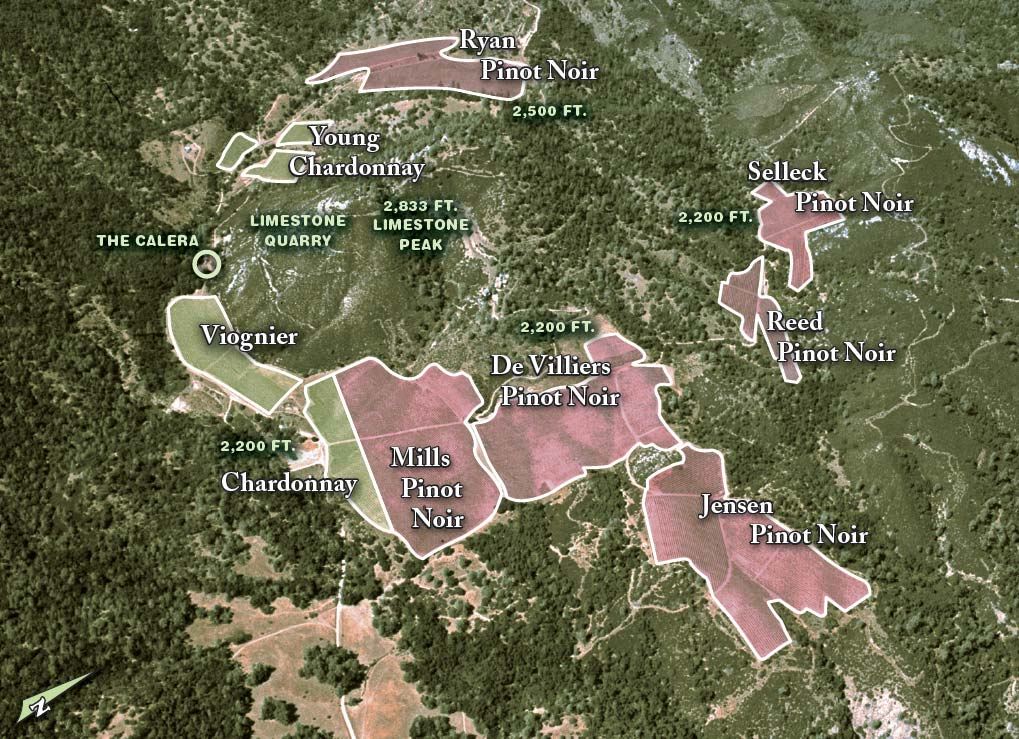 recently tasted the 2008 Calera single-vineyard Pinot Noirs and the 2008 and 2009 Calera Central Coast blend Pinot Noir. Calera vineyards suffered a devastating frost in the spring of 2008 resulting in yields that were extremely low, even by Calera’s usual small crop standards. There were only 3 barrels of Reed (sold to wine club members and a few export markets) and 1 barrel of Selleck (24 cases from the 4.8-acre vineyard and not released for sale). The Pinot Noirs that were produced are stunning but the limited production should induce you to act quickly to acquire the wines from the Calera website online store (www.calerawine.com) or the retail marketplace. Better yet, join the Limestone Circle Wine Club to insure receiving all the Mt. Harlan wines. There is no Mt. Harlan Cuvée Pinot Noir and no half bottles offered in this vintage. The 2008 Pinot Noirs are more forward than many Calera vintages, although all single-vineyard wines showed better the following day from a previously opened bottle and are very age worthy. The de Villiers Vineyard bottling is the most forward and a strikingly good value ($35). Prices for all the single-vineyard wines are ridiculously low considering the quality and breeding. The winery’s back labels are among the most informative in the wine business.
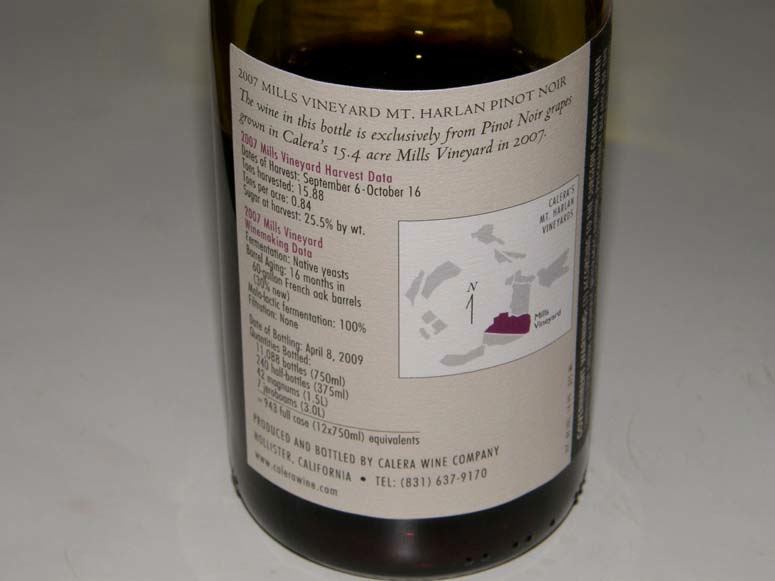 Calera Wine Company is located at 11130 Cienaga Road in Hollister. Calera welcomes visitors and tasting is available daily from 11:00 AM to 4:30 PM. Directions are on the website. 831-637-9170. The winery recently debuted their new website which is highly informative and visually appealing.

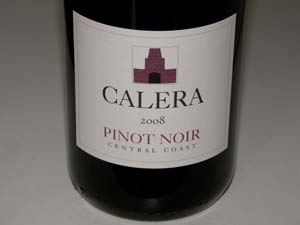 2009 Calera Central Coast Pinot Noir 14.3% alc., $24, glass closure. Sourced from seven vineyards in San Luis Obispo, San Benito, Santa Clara and Monterey counties (33% Latetitia Vineyard). Native yeast fermentation, aged 11 months in 10% new French oak barrels. · Moderately light reddish-purple color in the glass. Aromas of cherry glaze, dark red berry jam and black olives. A gentle, lighterstyled wine with bright cherry fruit on the modest mid palate attack, finishing with notes of cherry skins, oak, herbs and sandalwood. Well-mannered tannins for easy drinking, but enough structure to match up with hearty fall foods. Good (+).
2008 Calera Central Coast Pinot Noir 14.4% alc., $24, glass closure. Grapes sourced from Monterey County, San Luis Obispo County, Santa Clara County and San Benito County (50% from Scheid and Laetitia vineyards). 50% whole cluster, native yeast fermentation, aged in 10% new French oak barrels for 11 months without racking. · Moderate dark red color in the glass. Aromas of black cherries, brier, oak and pipe smoke. A brooding wine with little uplifting qualities, offering flavors of sweet black cherries, black raspberries and plums, finishing with a tarry, herbal, earthy presence. More dirt and oak than fruit and pretty ordinary. Decent.
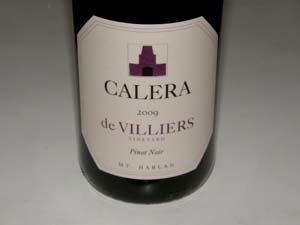 2008 Calera de Villiers Vineyard Mt. Harlan Pinot Noir 14.4% alc., 1,460 cases, $35. Yield 2.06 tons per acre. Native fermentation, aged 16 months in 30% new French oak barrels, bottled unfiltered. · Moderately deep reddish-purple color in the glass. Riper fruit profile on the nose offering scents of black currants, black cherries and Asian 5- spice. Moderately intense on the palate with flat out delicious flavors of black cherries and dark plums with an appealing minerality and earthiness underlain with a hint of citrus. Very smooth in the mouth with fine-grain tannins showing up on the richly endowed finish. Even more strikingly aromatic the next day from a previously opened and re-corked bottle, tasting of darker Pinot fruits. An ideal pretense to seduction.
2008 Calera Ryan Vineyard Mt. Harlan Pinot Noir 14.9% alc., 972 cases, $40. Yield 0.8 tons per acre. Native fermentation, aged 16 months in 30% new French oak barrels, bottled unfiltered. · Moderate reddishpurple color in the glass. Plenty to wow over with the ever-changing nose offering aromas of black cherries, boysenberries, baking spice, graham, dried fruits and subtle oak. Crisp and lively on the palate with earthkissed black cherries and raspberries, showing plenty of chewy tannins but enough bright acidity to offset and bring the wine into balance. Needs time to shed its structurally imposing fruit tannins. A touch of heat peaks out as the wine warms in the glass. Very good.
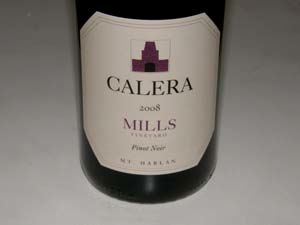 2008 Calera Mills Vineyard Mt. Harlan Pinot Noir 14.9% alc., 510 cases, $45. Yield 0.47 tons per acre. Aged 16 months in 30% new French oak barrels and bottled unfiltered. · Moderate reddish-purple hue in the glass. Plenty of interest in the nose with scents of dark red berries, sandalwood, seasoned oak, and pastry. Vibrant and amazingly intense on the mid palate attack with flavors of dark red berries and dark red cherries wrapped in gentle, fine-grain tannins. The fruit refuses to give up its presence on the spectacular peacock finish. A touch of heat shows up on the nose and finish, but this seems trivial considering the impressive palate presence of this wine. Outstanding the following day from a previously opened and re-corked bottle.
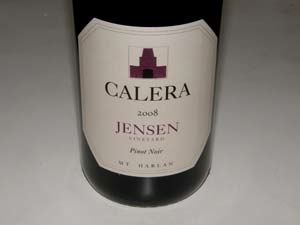 2008 Calera Jensen Vineyard Mt. Harlan Pinot Noir 14.7% alc., 829 cases, $70. Yield 0.86 tons per acre. Aged 16 months in 30% new French oak and bottled unfiltered. · Moderately light in color with mainly reddish tones. Subdued but seductive aromas of dark red cherries and berries, charcoal and spice. Lighter in weight than the other Calera single-vineyard offerings in this vintage and unusually light for Jensen. Flavors of ripe strawberries, red cherries and red raspberries with an appealing spice box accent, enrobed in well-proportioned dusty tannins which peek out on the dry and persistently aromatic finish. Very creamy and soft in texture. Calera’s signature Pinot Noir, deserving of all the accolades one can muster for this vintage.
Cristom Vineyards: Calera HeritageIt seems only fitting to follow a feature on Calera Wine Company with an article on Cristom Vineyards. Steve Doerner was the first winemaker at Calera Wine Company and has been Cristom’s winemaker since the winery’s first vintage in 1992. He is now a partner in the winery with Paul Gerrie. Doerner graduated from the University of California Davis in 1979 with a degree in biochemistry. His interest in winemaking came from his scientific curiosity. He studied under Jacques Seysses, the owner and winemaker at Domaine Dujac in Burgundy, and spent 14 years at Calera Wine Company before arriving at Cristom. He names Burt Williams, the co-founder and original winemaker at Williams Selyem, as one of the vintners who greatly influenced him. He was the first high-profile California winemaker to exit California for Oregon (Steve’s photo below).
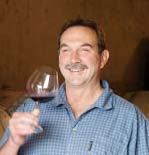 When engineer Paul Gerrie acquired the defunct Pellier Winery site in Polk County near Salem in 1992, the vineyards were in disarray and all but one had to be restored. Gerrie and his wife Eileen admit they bought the property on nothing more than a hunch. On his travels to France, Paul had learned about the traditional growing practices of Burgundy and the importance of terroir. After attending the 1991 International Pinot Noir Celebration, he decided the time was right to leave the East Coast and bring his family to Oregon’s Willamette Valley. Cristom, which is located in Eola-Amity Hills AVA, farms eight estate vineyards with Marjorie the only vineyard not restored after purchase of the winery. From 1993 to 1996, the vineyards were replanted and the first wines from estate fruit came from the 1994 vintage. Vineyardist Mark Feltz oversaw the replanting and has managed the vineyards since its founding in 1992. All vineyards are dry farmed and relatively high density planted. Cristom farms a total of 75 acres (48.5 acres of Pinot Noir) spread over eight estate vineyards. Seven of the vineyards are named after women in Paul Gerrie’s family including his wife Eileen. The vineyards are as follows: Marjorie (8.5 acres of Pinot Noir first planted in 1982; first designated release was in 1994), Louise (9.5 acres of Pinot Noir; first designated release was in 1996), Jessie (11.5 acres of Pinot Noir; first designated release was in 1998), Eileen (15.25 acres of Pinot Noir; 4.5 acres added in 2006; first designated release in 2000), Emilia (5 acres of Pinot Gris planted between 1993 and 1996), Germaine (named for Doerner’s maternal grandmother; 4.5 acres of Dijon 75 and 95 clone Chardonnay), and two unnamed vineyards, one planted to Viognier and one to Syrah. Pinot Noir clones in the estate vineyards include Wädenswil (UCD 2A), Pommard, and Dijon 113, 114, 115, 667 and 777. Cristom produces vineyard-designated Pinot Noirs from the four vineyards, Marjorie, Louise, Jessie and Eileen. The wines represent a selection of favorite barrels from the vineyard. Because of varying elevations, exposure and soil types, each vineyard produces a distinctive style of wine. Three Pinot Noir blends, all reasonably priced and produced in quantity are also offered: the Mt. Jefferson Cuvée (about 3,500 cases) which includes purchased grapes, the Sommers Reserve (about 1,250 cases) which is a selection of the best barrels intended for the Mt. Jefferson Cuvée, and the Signature Cuvée. Syrah, Pinot Gris, Chardonnay and Viognier are also available. Total production is about 10,000 cases annually. All Cristom estate wines, and the winery, are certified sustainable by L.I.V.E. and the single-vineyard Pinot Noirs have received the O.C.S.W. seal of approval (Oregon Certified Sustainable Wines). Doerner uses about 50% whole clusters making his wines which is unusual for Oregon producers. I am a sucker for properly vinified whole cluster fermented Pinot Noirs because I find the resulting spice, the tannin structure and the age ability particularly appealing. Not surprisingly, native fermentations are the rule for Doerner as he was one of the first proponents of natural yeast fermentations for Pinot Noir. Acid additions are employed to achieve balance when necessary. Both press and free-run juice are combined and sent to barrel where the single vineyard Pinot Noirs receive a relatively high percentage of new oak (58% to 67% in the 2008 vintage). The wines undergo egg white fining but no filtration. Not surprisingly, the winemaking regimen is very similar to that initiated by Doerner at Calera Wine Company which is still in place at that winery today. Cristom Vineyards wines are sold through the winery website at www.cristomwines.com, the tasting room, and distribution through fine wine retailers. The tasting room at 6905 Spring Valley Road NW in Salem, Oregon, is open Tuesday through Sunday, 11:00 AM to 5:00 PM March to December, and by appointment January and February. Several of the wines are available in half bottles which are ideal for earlier consumption. Magnums and library wines are sold through the winery’s online store.
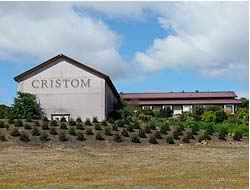 I recently sampled a few older vintages direct from the winery, a ¡Salud! Cuvée Pinot Noir from 2007, as well as the four single vineyard Pinot Noirs and two blend Pinot Noirs from the 2008 vintage. The 2009 Mount Jefferson Cuvée has been released and is reviewed here as well. The 2008 vintage wines offer robust extraction of very ripe fruit, significant tannins and limited approachability at this stage. All the single vineyard Pinot Noirs are in very heavy bottles.
2017 Cristom Marjorie Vineyard Eola-Amity Hills Willamette Valley Pinot Noir 14.0% alc., pH 3.60, TA 0.55, 384, cases, $65. Clones are Pommard, Wädenswil and Dijon 115 and 777. 51% whole clusters, native yeast fermentation, aged 18 months in French oak barrels, 75% new. Fined with egg whites and unfiltered. · Moderate garnet color in the glass. Brooding aromas of black cherry, rose and leaf. The fruit trends more to the dark red spectrum in this middleweight wine. The ripe tannins are in gorgeous balance, and the lasting finish soars with exceptional cherry goodness. More expressive and more seductive when tasted the following day from a previously opened and re-corked bottle. Score: 95
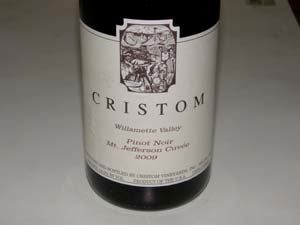 2009 Cristom Mt. Jefferson Cuvée Willamette Valley Pinot Noir 14.2% alc., pH 3.70, TA 0.54, 5,936 cases, $30 (often discounted). From 12 vineyard sites in the Willamette Valley including 38% estate fruit. The first of the Cristom Pinot Noirs to be released each year. Produced at Cristom since 1994. It is named for Mt. Jefferson in the Cascade Range due east of Cristom and visible from the winery’s tasting room. · Moderate reddish-purple color in the glass. The nose offers aromas of attractively spiced dark red berries and cherries, broadening over time in the glass to even deeper autumnal notes of wet leaves and truffles. Moderately intense flavors of berry jam and Hoison sauce with hints of oak, anise, mushrooms and earth, nicely framed by firm, dry tannins and lifted by crisp acidity. A juicy wine that is easily drinkable now, but will benefit from a modest time in the cellar to further soften the tannins. Can work as an everyday drinker or can dress up the dinner table on a special occasion. Very good.
2008 Cristom Sommers Reserve Willamette Valley Pinot Noir 14.2% alc., pH 3.77, TA 0.55, 2,058 cases, $41. Fruit from four estate Pinot Noir vineyards (73%) combined with purchased fruit for a total of 14 vineyard sites and 7 Pinot Noir clones. First produced in 2004, ‘Sommers’ is Jessie’s (of Jessie Vineyard) maiden name. 47% whole clusters. Aged 17 months in 59% new oak barrels. · Moderately light reddish-purple color in the glass. Muted nose initially, opening slowly to reveal appealing aromas of red cherries and berries, fruitcake and spice. Light in weight and wanting a little in the attack and finish, the wine still has charm and reasonably good approachability. There are still prominent dry tannins that need time to recede. The wine gets better in the glass over time, picking up some flavor intensity, suggesting further cellaring is necessary. Good (+).
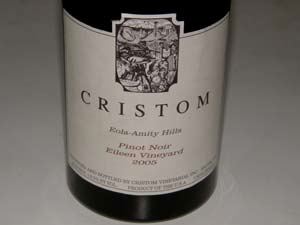 2008 Cristom Eileen Vineyard Eola-Amity Hills Willamette Valley Pinot Noir 14.0% alc., pH 3.82, TA 0.54, 659 cases, $50. Highest elevation and youngest of the estate Pinot Noir vineyards. Vines are planted at high density in primarily Jory soil. First of the estate vineyards to be farmed entirely by organic methods. 43% whole clusters. Native yeast exclusively. Aged 17 months in 59% new Burgundian oak barrels. · Moderately dark reddish-purple color in the glass. Subdued and mysterious perfume of black fruits, spice and stem. Fresh and juicy on the palate with very impressive extraction and a prodigious tannic backbone. The flavors of fresh blackberries, Hoison sauce and Asian 5-spice are reserved and take a back seat to the tannins. Still, there is amazing grand cru quality persistence on the huge finish. Tremendous potential here but will take years to fulfill.
2008 Cristom Jessie Vineyard Eola-Amity Hills Willamette Valley Pinot Noir 14.0% alc., pH 3.88, TA 0.54, 656 cases, $50. Steeply sloped vineyard planted to high density. Primarily Nekia soil of volcanic origin. Dijon 113, 114, 115, 667, 777 and Pommard clones. 44% whole clusters, native yeast used exclusively. Aged 17 months in 63% new Burgundian oak cooperage. · Medium reddish-purple robe in the glass. Aromas of jam on toast, woodshed and black cherry cola. Moderately extracted dark red and blue fruits with a touch of stem on the dry finish. The wine has a burly tannic backbone that is buffered by good acidity. Showing significant tannin and oak influence and reserved fruit now like so many young Pinot Noirs from Oregon’s 2008 vintage, several years will be needed for the wine to fully reveal its charms. Very good.
2008 Cristom Louise Vineyard Eola-Amity Hills Willamette Valley Pinot Noir 14.5% alc., pH 3.86, TA 0.56, 575 cases, $50. Lowest elevation hillside vineyard planted to high density of 2300 vines per acre. Pommard, 2A, 114, 115 and 777 clones. 42% whole cluster and 100% native yeast fermentations. Aged 18 months in 58% new Burgundian oak barrels. · Medium garnet color in the glass. Very alluring aromatics offering scents of fresh red berries, particularly strawberries, with hints of fruit and oak spice. Moderately robust on the palate with sweet flavors of dark red berries and cherries, well-mannered ripe tannins, and a very long finish imbued with dark red berries. The most upfront charm of all the 2008 single vineyard Pinot Noirs. My only nit is that a little alcohol shows up on the nose and finish. Very good.
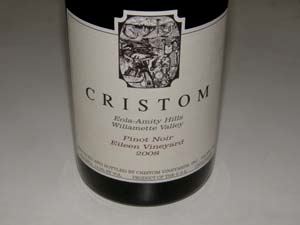 2008 Cristom Marjorie Vineyard Eola-Amity Hills Willamette Valley Pinot Noir 14.5% alc., pH 3.70, TA 0.56, 440 cases, $65. Soils have highest percentage of Jory type compared to other estate vineyards. Pommard, Wädenswil, Dijon 114, 115 and 777 clones. 43% whole clusters. Native yeast fermentation in 1 to 5 ton open top fermenters. Aged 18 months in 67% new Burgundian oak barrels. · Moderately dark reddish-purple color in the glass. A well-composed wine with complex perfume of dark red raspberry jam and cherry compote with hints of oak, damp earth and baking spice. Very smooth on the palate with moderately intense flavors of dark red fruits and plum sauce. The high-quality fruit is wrapped in firm, dry tannins, the mouth feel is all silk and satin and there is a good cut of acidity on the finish. The wine is a bit drab at present and only time will tell what the ultimate outcome will be, but I suspect the result will be very gratifying. Very good.
2007 Cristom ¡Salud! Cuvée Willamette Valley Pinot Noir 13.5% alc., very limited production auction item. · Moderately light reddish-purple hue in the glass. This wine is well-endowed with spice both in the aromatics and on the palate. The nose offers an interesting mix of red fruits, game and exotic woods. On the palate, lighter weighted flavors of red cherries have a slight green note in the background. The tannins are dusty and supple and there is a bright cut of acidity on the short finish. A delicate wine that is typical of the 2007 vintage in Oregon, showing subtle signs of unripeness. Still, a good quaff. Good (+).
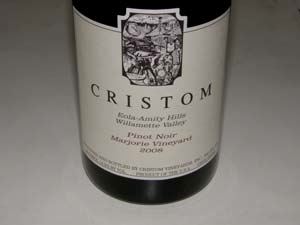 2005 Cristom Eileen Vineyard Willamette Valley Pinot Noir 13.5% alc., $65, sold out. · Dark reddish-purple color in the glass. Terrific aromatics offering plenty of whole cluster spice, dark red fruits and a hint of brioche. Delicious array of dark red and black stone fruits impress the mid palate with verve and intensity. Nicely proportioned fine grain tannins and acidity with a silky texture and a finish redolent of cherry skins. Still coming around and has plenty of life ahead.
2004 Cristom Louise Vineyard Willamette Valley Pinot Noir 13.5% alc. (14.5% on winery tech sheet), pH 3.77, TA 0.68, 583 cases, $65. 30% whole clusters, 100% native yeast fermentations. Aged 18 months in 63% French oak barrels. · Moderate reddish-purple color in the glass. Faint aromas of black cherries, spice, humus and herbal tea. Relatively light in weight with appealing flavors of cherries and raspberries with subtle notes of spice and earth. Soft, but evident tannins provide substance and the finish ends on a high note with well-honed aromatic red fruits. Should last another 5 to 10 years. Very good.
2000 Cristom Eileen Vineyard Willamette Valley Pinot Noir 14.0% alc., $60, sold out. · Dark, inky in color in the glass. Brooding nose offering aromas of bramble, grass and earth. Rustic, loamy and brutish offering moderately intense dark berry fruits on the palate with very prominent oak tannins. Simply put, this wine offers little charm. Drink up. Decent.
Laura Volkman Vineyards: A Whisp of a Winegrower under that HatRegular readers of the PinotFile know that I have been a fan of the Pinot Noirs from Laura Volkman Vineyards and have written extensively about Laura and her wines since 2008 (see www.princeofpinot.com/article/736/ for the most recent article). Laura farms 3.5 acres of Pinot Noir at her Elle Rêve Vineyard adjacent her home in the Chehalem Mountains of Oregon. The vineyard is planted primarily to Dijon 115, with lesser amounts of 114, 667, 777 and Pommard clones. Unlike most winemaking ventures where the husband is the principal vineyardist and winemaker, Laura is the one who performs nearly all the vineyard and cellar work. For the most part, she doesn’t allow anyone else, even her husband, Jim, to monkey with the vines. For a very slight woman who weighs a hair over 100 pounds, you have to admire her gumption. Jim has his own profession, and provides a helping hand and support only if needed.
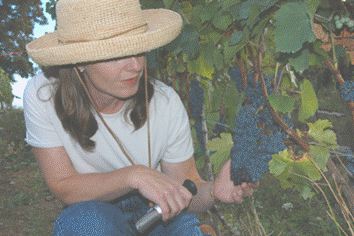 Cool fermentations are preferred because Laura believes they preserve the delicate aromas of Pinot Noir. Various proprietary yeasts are used to create the distinctive flavor profiles that set apart her two major bottlings, Rachel Estate and Jacob Estate, named after her two children. The Rachel Estate is the more feminine wine produced from the west block of the vineyard and includes clones 114, 667 and Pommard. The Jacob Estate is sourced from the east block of the vineyard and is composed of clones 114, 115 and 777. It is the most robust and more darkly fruited of the pair. The Pinot Noirs are raised in a modest percentage of new French oak barrels without racking. The wines are unfined and unfiltered. Winemaking is performed at nearby August Cellars. The Laura Volkman Vineyards labels display artwork depicting Laura in her vineyard wearing a red dress and her trademark straw hat drawn by noted watercolor artist, Terry Peasley. Beside the Rachel Estate and Jacob Estate, there is an earlier drinking Pinot Noir named after her husband, St. James Estate, and a Chardonnay sourced from the Celilo Vineyard in the Columbia Gorge region of Washington named after the family dog, Bella. Total production is less than 500 cases annually. The wines are sold through a mailing list and on the website at www.volkmanvineyards.com as well as retailer www.northwestwines.com. Tasting is available by appointment at the vineyard property in Newberg, Oregon (503-806-4047). I recently reviewed the Laura Volkman Vineyards estate Pinot Noirs from the 2008 and 2009 vintages. All the wines have remarkably suffuse aromatics, silky tannins, powerful flavors in an elegant style and proper balance for medium-term age ability. The 2009 vintage wines are more precocious and promiscuous, while the 2008 vintage wines, which ultimately will prove to be more age worthy, are still in need of further cellaring. The Rachel Estate bottling is more demure and seductive like fine lingerie and more nuanced, while the Jacob Estate Pinot Noir is more aggressive, macho and darker fruited.
2009 Laura Volkman Celilo Vineyard Bella Washington Chardonnay 14.7% alc., pH 3.60, 220 cases, $25. Wente clone. Partial MLF. Fermented in 50% oak (25% new) and 50% stainless steel. · Light straw yellow color in the glass. Aromas of lychee, gooseberry, parchment and a slightly pungent aroma that defies my description. More traditional flavor profile in the mouth with the taste of apple, pear, and flint, finishing with a hint of citrus and lees. Decent.
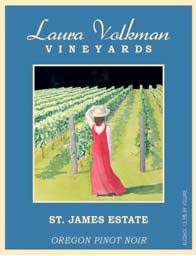 2009 Laura Volkman St. James Estate Oregon Pinot Noir 13.7% alc., pH 3.70, 320 cases, $25. · A blend of Rachel and Jacob blocks of the vineyard. No new oak. Moderately light reddish-purple color in the glass. Very nicely composed perfume of black cherries, baking spice and subtle herbal oak. A solid wine with appealing flavors of dark red stone and berry fruits with underpinnings of herbs, tea and tobacco. Very bright acidity leaves a refreshing impression on the short finish. A perfect wine for enjoying now at the dinner table. Good (+).
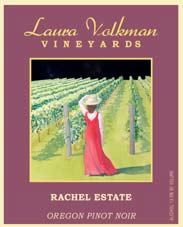 2009 Laura Volkman Rachel Estate Oregon Pinot Noir 13.7% alc., pH 3.70, 125 cases, $40. Pommard, 667 and 114 clones. Aged on the lees in 35% new French oak barrels. · Moderate reddish-purple color in the glass. I had to look up some superlatives for this one. The perfume reminds me of the first crop of fresh berries in the early summer covered in vanilla pastry creme. Silky and elegant on the palate with well-mannered fine grain tannins and intensely flavorful core of black cherries, raspberries, sandalwood, vanillin, herbs and spice brought into focus with a good cut of acidity. The most appropriate superlative I could find was “heavenly.”
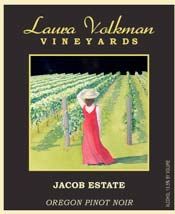 2009 Laura Volkman Jacob Estate Oregon Pinot Noir 13.7% alc., pH 3.70, 125 cases, $50. Clones 777, 115 and 114. Aged on the lees in 35% new French oak barrels. · Moderately intense reddish-purple color in the glass. Reserved, but seductive aromas of dark plum reduction sauce, blackberries, shaved oak and truffle. More intense than the Rachel Estate, with a plethora of darker fruit flavors including plum, blackberry and cassis that hang around on the palate and keep on giving on the long, long finish. An underlying earthy quality adds interest and supple tannins make for easy drinking. A hunk with charm.
2008 Laura Volkman Rachel Estate Oregon Pinot Noir 13.5% alc., 100 cases, pH 3.74. $40. A blend of Pommard, 667 and 114. Aged in 50% new French oak barrels. · Moderate reddish-purple color in the glass. Demure but alluring perfume of perfectly ripe black cherries and black raspberries, cut flowers and a swirl of spice. The nose is flat-out great. Medium-weighted and lush mixed dark red berry fruit coats the palate, expands in the mouth and lingers on the long finish. The ripe tannins are noticeable, yet not imposing. More sap than the 2009 vintage, but less giving at this stage. This wine is very seductive now, but will ultimately be a bombshell.
2008 Laura Volkman Jacob Estate Oregon Pinot Noir 13.5% alc., $50, 100 cases, pH 3.74, sold out at winery. Blend of clones 777, 115 and a small amount of Pommard. Aged in 50% new French oak barrels. · Moderate reddish-purple color in the glass. Enticing aromas of spiced berry jam and crushed cherries with a loamy note in the background. Moderately intense and flavorful with noticeably ripe, dark mixed berry fruits framed by firm tannins, finishing with bright acidity, a riff of savory herbs, and some aromatic persistence. Needs more time to integrate the tannins, but this wine will always have a tannic presence. The fact that this wine is sold out indicates high consumer regard for this wine. Very good.
Sea Smoke Cellars: California Cult ClassicSea Smoke is one of a handful of California Pinot Noir producers whose fruit-powered style has quickly captured the attention of pinotphiles. Bob Davids, a Burgundy aficionado and CEO of a highly successful computer game company, acquired 350 acres of farmland overlooking the Santa Ynez River in 1999 and began development of the 105-acre Sea Smoke Vineyard the same year. He chose south-facing hillside bluffs situated above Fiddlestix Vineyard in the Sta. Rita Hills appellation of Santa Barbara County. From the beginning, the emphasis has been on meticulous vineyard management led by a highly skilled vineyard team. Ten Pinot Noir clones are planted in 26 unique geographic blocks of the large vineyard which has six soil types and elevations ranging from 300 to 700 feet above sea level. The first photo below of Sea Smoke Vineyard is taken from Fiddlestix Vineyard looking toward the north with Sea Smoke vines on the hillsides in the distance. The second photo shows the Sea Smoke Vineyard from its highest point with Fiddlestix Vineyard in the foreground, then Santa Rosa Road, Sanford & Benedict Vineyard, La Encantada Vineyard, and the Santa Rosa east-west mountain chain visible in the distance. The third photo shows one aspect of the Sea Smoke Vineyard.
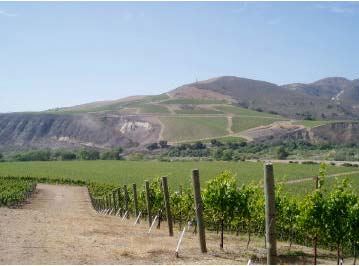
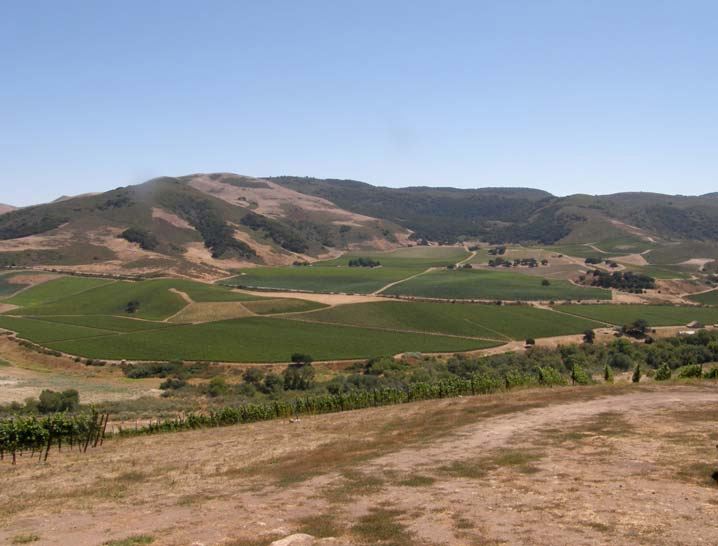
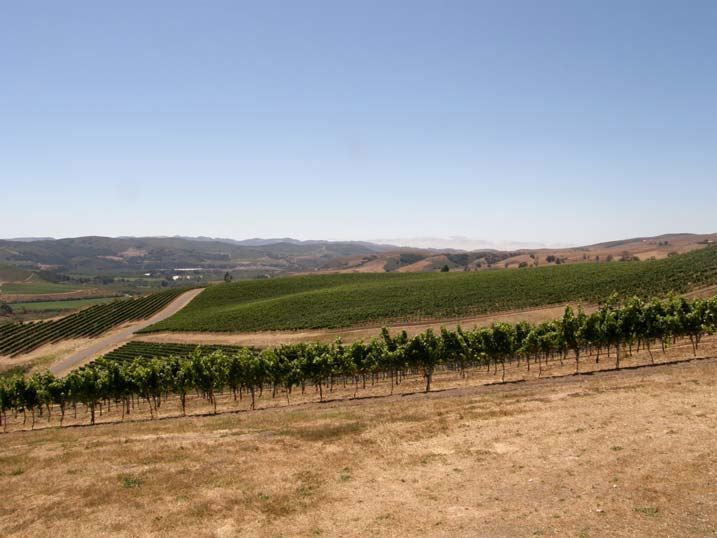 The Pinot Noir clones planted include Dijon 113, 115, 459, 667, 777, 09, 16, Pommard 5, 2A, and Mt. Eden Selection. The Chardonnay clones are Wente and Dijon 76, 95 and 96. Individual blocks and clonal combinations are vinified separately and provide a complex palate for blending decisions intended to reflect the terroir of the site. The initial winemaker was Kris Curren, who left in 2007 to join Foley Estates, replaced by Don Schroeder who was Curran’s assistant and a winemaker at Ampelos Cellars. Victor Gallegos, educated at University of California Davis, is the director of winemaking and viticulturist. Schroeder has proven to be a fortunate hire, for working together with Gallegos, the pair have taken the wines in a subtle, but more appealing direction in my opinion, with less alcohol, slightly less extraction, and reduced new oak elevage. According to the winery spokespeople, “The 2009 vintage marked the culmination of a subtle stylistic shift at Sea Smoke - a measured fine tuning to further enhance the aging ability of Sea Smoke’s wines, through slightly lower alcohol levels and the finessing of new oak ratios during barreling.” They have not changed their picking regime, which is still aimed at tannin and flavor ripeness but have altered their winemaking regimen without resorting to de-alcoholizing the wines. The first Sea Smoke Pinot Noir was released from the 2001 vintage and instantly acquired an enthusiastic following. A new winery was built in Lompoc and the 2009 vintage, reviewed here, was the first to be vinified there. The large space available in the new winery and almost 40 fermenters allows for focused work with the 50 distinct small individual fermentation lots. Yields were the highest ever from the Sea Smoke Vineyard in 2009 at 2.3 tons per acre, but the cluster counts per vine remained the same; quite low but with each cluster’s weight greater. More mailing list members were offered wine in 2009, but unfortunately, yields dropped back to normal in 2010. Beginning in 2002, there have been three Pinot Noirs produced at Sea Smoke: Botella which is fruit forward with mild tannins; Southing, which is darker and more reticent initially; and Ten, which is made from a barrel of each of the ten clonal selections grown on the estate vineyard. The Ten bottling has been crafted to be more robust, vinified with a larger percentage of new oak that is from coopers with a more aggressive style, resulting in more long-term age ability potential. A Chardonnay is produced from three acres planted in the estate vineyard. The wine was initially intended for charitable purposes and as a reward for mailing list members, thus the name “Gratis” for the wine. Many customers requested that the Chardonnay be made available for purchase. An additional five acres of Wente clone Chardonnay was planted in 2005 and beginning that year, a “Sea Smoke Chardonnay” was crafted along with “Gratis.” Gratis is crafted with power and richness, while the Sea Smoke Chardonnay is more elegant and refined because of a different cooperage program and the use of 25 percent stainless steel during fermentation. After sorting the grapes, the must undergoes a 1 to 4 day cold soak and is then inoculated with cultured yeasts. The slow fermentation and maceration takes fourteen to eighteen days for the Southing and sixteen to twentyeight days for the Ten. After settling, both free-run and press wines are racked to barrels and aged 16 months in 55% new (Southing) and 65% new (Ten) French oak barrels. For the Sea Smoke Chardonnay, cold grapes are softly pressed, cold settled and racked to both French oak barrels and a stainless steel fermenter. The must is inoculated for primary fermentation and barrels are periodically stirred. The wine is aged 16 months in 55% new French oak barrels before bottling. Sea Smoke wines are sold almost exclusively through distributors and a mailing “List” and highly allocated. Visit the website at www.seasmoke.com to join the list. For questions about the list contact customerservice@seasmokecellars.com. No tasting room is available at Sea Smoke because all the wine is pre-allocated to List members. Occasionally wine is available at the Taste of Santa Rita Hills tasting room in the Lompoc wine ghetto (www.tasteofstritahills.com). The winery is not open to the public for tours and vineyard visits are not possible due to legal restrictions on public access.
2009 Sea Smoke Southing Sta. Rita Hills Pinot Noir 14.5% alc., pH 3.33, VA 0.67, $52. · Moderately deep reddish-purple hue in the glass. Very reserved nose offering demure aromas of black fruits, oak char and spice and violets. The black plum, cassis and black cherry fruit has impressive presence on the mid palate, underscored with appealing earthy, iron and mineral character. The tannins are fine-grain and accommodating and there is a good cut of acidity in the background. This seductive wine ends with an aromatic whiff of musk and flowers. Shows an elegance missing from previous Sea Smoke vintages. Very good.
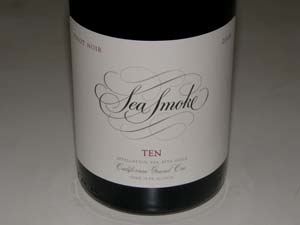 2009 Sea Smoke Sta. Rita Hills Chardonnay 14.9% alc., pH 3.42, TA 0.63, $52. · Light straw yellow color in the glass. The nose offers reserved aromas of honeycomb, lemon pastry, sandalwood and a hint of mocha. Well-endowed with flavors of lemon curd, baked apple, roasted nuts and toasty oak. Creamy on the palate with integrated acidity and a dry, citrus-driven finish. Very good.
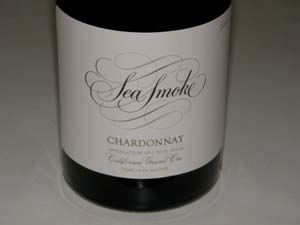 2009 Sea Smoke Ten Sta. Rita Hills Pinot Noir 14.5% alc., pH 3.39, TA 0.67, $80. · Moderately deep reddish-purple color in the glass. Fresh and vibrant perfume of purple berry compote, plum reduction sauce and hibiscus tea, offering displaying more intensity over time in the glass. This wine offers flavors of blackberries, Hoison sauce in perfect balance with refined tannins and vital acidity. The purity of the fruit really grabs your attention as it unfolds in layers across the palate. The mouth feel is velvety, the oak is beautifully integrated, and there is very impressive length on the fruit-laden finish and a step up in pleasure from the Southing bottling. Honed to go the distance in the cellar.
2002 Sea Smoke Southing St. Rita Hills Pinot Noir 14.1% alc.. · Dark reddish-purple color in the glass. Bright aromas of darker berry compote with notes of graham and leaf. Richly endowed with appealing dark berry fruit, showing an earthy and smoky tone, and lashed with oak and firm tannins. Still holding and should last several more years but will always be a tannic wine. Good (+).
2001 Sea Smoke Botella Sta. Rita Hills Pinot Noir 14.1% alc.. Inaugural vintage. · Moderately dark reddish-purple with slight bricking of the rim. Brooding aromas of prunes, oak, herbs and cardamom spice. Moderately rich and ponderous with a core of very ripe, roasted dark fruits including black raspberries and black plums. Noticeable oak tannins with hi-tone acidity on the finish. Meant for earlier drinking and has run its course. Drink up. Decent.
Sea Smoke caused a bit of a stir when they released their 2009 wines with the phrase, “California Grand Cru,” on the front label. Naysayers pointed out that the Sea Smoke vineyard is only a little over ten years old, with not enough vintages to justify such a claim of distinction. Currently, California does not have a formal classification of vineyard quality such as Burgundy's cru system based on well-defined climats. This is understandable, as most California Pinot Noir vineyards are relatively young. As Remington Norman points out in his new book, Grand Cru, “The working idea of Grand Cru is both thoroughly Burgundian and thoroughly pragmatic. It reflects the fact that over the centuries the quality of wines from certain plots has consistently out performed that of their neighbors, irrespective of the grape variety planted on them.” The important word here is “centuries.” In Burgundy, even with that much experience with specific vineyards, there remains controversy over the classification with some Grands Crus (or at least part of the vineyard) undeserving of that designation and some Premier Crus deserving of the title, but not so designated. Not to brag, but to make a point, I have tasted Pinot Noir from every notable Pinot Noir vineyard in California. Considering my experience and the quality of the wines tasted (aromatic interest, complexity, persistence after swallowing, and capacity to age with interest), the following vineyards come to mind when I think of California vineyards of potentially Grand Cru quality: Calera Jensen, Hanzell, Mount Eden, Donum Estate, Rochioli, Summa, Hirsch, Savoy, Pisoni, Bien Nacido, and Fiddlestix. Beyond these choices, there are literally hundreds of vineyards for which arguments could be made for inclusion in this select club. It is a fertile (sic) topic to debate, but do not look for a vineyard classification system to be forthcoming soon in California. The biggest challenge to arriving at such a classification would be determining who would decide?
2009 California Praiseworthy Pinots
Anthill Farms WineryA trio of winemakers who had worked together as cellar hands at Williams Selyem launched their own winery with three Pinot Noir releases in 2004. Anthony Filiberti grew up in Sonoma County and was lured to wine at an early age, perfecting his craft at Bergstrom Winery in Oregon, Hafner Vineyards in the Alexander Valley, and Williams Selyem. David Low grew up in Kansas but became hooked on wine while attending University of California at Berkeley. A short stint as a computer programmer was followed by a change of heart and he later worked at both Williams Selyem and Papapietro Perry where he is also an assistant winemaker. Webster Marquez grew up on the East Coast and attended school in Virginia. He worked as an assistant winemaker at Jefferson Vineyards before moving to Sonoma County where he joined Williams Selyem. He was the previous winemaker at C. Donatiello Winery in Healdsburg (now closed). The emphasis at Anthill Farms is on the vineyards and the name of the winery reflects the multiple small individual vineyards that form the owners’ “link between place and product.” The trio of winemakers prefer to bring notoriety to their winegrowers at North Coast vineyards in Sonoma and Mendocino counties. The annual production of 1.400 cases, which includes Syrah, is quickly snapped up by an eager mailing list. Tasting is by appointment in Healdsburg. The website is www.anthillfarms.com.
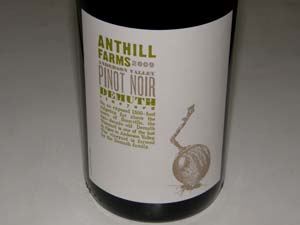 2009 Anthill Farms Demuth Vineyard Anderson Valley Pinot Noir 13.3% alc., $44. This 20-year-old vineyard sits at 1,400 to 1,600 feet above Boonville and is farmed by Anthony Filiberti and the Knez family who own the property. Clones are Pommard and Wädenswil. · Moderately light reddish-purple color in the glass. Deeply aromatic with scents of dark cherries, pipe smoke, spice and seasoned oak. Crisp and bright on the palate with vivid flavors of dark red cherries, raspberries and cranberries with subtle hints of spice and smoke. Pillowy tannins create a very smooth mouth feel. Terrific the next day from a previously opened and re-corked bottle.
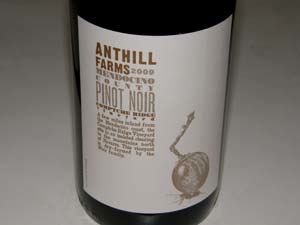 2009 Anthill Farms Comptche Ridge Vineyard Mendocino County Pinot Noir 13.8% alc., $44. This 3-acre vineyard is situated north of Navarro above the town of Comptche and just inland from the northern Mendocino Coast. It is dry-farmed by the Weir family. Planted exclusively to Swan clone, yields are 1 ton per acre. · Medium dark purple-red color in the glass. This wine is very upfront after opening. Deep, dark and mysterious nose offering aromas of blackberries, black plums, underbrush and subtle oak. Impressive fruit intensity on the attack and on the finish which persists for what seems like a minute. Rugged and masculine in character with ripe, firm tannins yet possessed with a modicum of finesse. Displays an earth and mineral laden undertone that speaks to the terroir of this region. Spectacular the next day from a previously opened and re-corked bottle.
Drew Family CellarsThis winery has been featured on multiple occasions in the PinotFile because the winemaking is so consistently superb that I have never had a disappointing wine from owner and winemaker Jason Drew. In 2000, Jason founded the Drew label with his wife Molly while he as an associate winemaker at Babcock Vineyards & Winery in the Santa Rita Hills. In 2002, he left Babcock to concentrate on his own label, and two years later purchased a 26-acre ridge top property overlooking the Anderson Valley in the Mendocino Ridge appellation. A winery and home were built on the property and vineyard planting began in 2010. Drew’s vineyard will be one of the most westerly vineyards on the North Coast. Grapes are currently sourced from the Anderson Valley, Sonoma Coast, Mendocino Ridge, and Yorkville Highlands. Vineyards sources have changed with vineyard ownership switches over recent years. Drew wines are sold through a mailing list and retail channels, and at the tasting room in Philo. Interested Pinot lovers should join the mailing list and the Pre- Release Wine Club to insure access to the limited production wines (1,800 cases annually). Visit the website at www.drewwines.com.
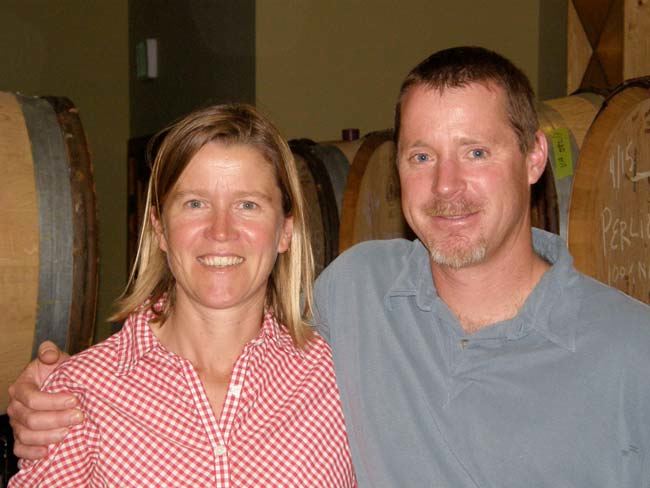
2009 Drew Perli Vineyard Murder Ridge Block Mendocino Ridge Pinot Noir 13.9% alc., $40. From a steep ridge top vineyard laden with volcanic rock at 2,000 feet elevation about 10 miles from the Pacific Ocean. · Moderately dark reddish-purple color in the glass. A chameleon of a wine that changes in the glass over time. Many aromas show up including Herbs de Provence, red berries and cherries, spice, almond paste and a floral note. Medium weighted vivid flavors of dark red cherries, raspberries and plums with a savory component, well-mannered tannins and a good cut of acidity on the bright finish. Very good (+).
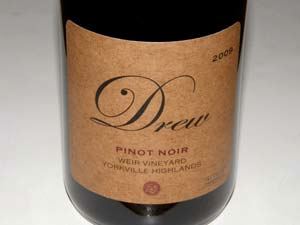 2009 Drew Weir Vineyard Yorkville Highlands Pinot Noir 13.9% alc., $40. Fifth vintage of this wine. This 15-acre vineyard is situated at the southeastern border of Anderson Valley amongst the redwoods. Planted by owner Bill Weir to a California heirloom clone purported to be from DRC, cuttings from Rochioli River Block, Pommard 4 and Wädenswil 2A. I have had some marvelous wines from this vineyard through the years and this vintage is no exception. · Moderate reddish-purple color in the glass. Complex nose that unfolds slowly revealing many nuances including aromas of dark berries and black plums, mushrooms, bramble, spice, and rose petal. Delicious core of fresh plum compote wrapped in firm, but well-honed tannins, attacking the mid palate with conviction, and persisting on the soft finish that shows a riff of citrus and a perfume of plum sauce. Deft balance between richness, acidity and tannin. It is wines like this that make Pinot my paramour.
Freestone VineyardsJoseph Phelps Vineyards farms three distinct vineyard properties in the hamlet of Freestone, a very cool climate region located in west Sonoma County. The Pastorale Vineyard lies adjacent the hillside Freestone Vineyards winery and consists of 34 acres of Pinot Noir and 21.7 acres of Chardonnay. Quarter Moon Vineyard is further west and is planted to 41 acres of Pinot Noir. Ferguson Vineyard, located just north of the winery, contains 6 acres of Pinot Noir and is farmed under a long-term lease. Director of Winemaking is Phelps veteran Damien Parker, the Winemaker is Theresa Heredia, and the Consulting Winemaker is noted Burgundian Pascal Marchand. Fogdog Sonoma Coast Pinot Noir and Chardonnay are the winery’s entry level offerings, composed of a blend of grapes from the three estate vineyards. The Freestone Sonoma Coast Pinot Noir and Chardonnay and Ovation Chardonnay are premium bottlings composed of grapes from the estate vineyards. Vineyard-designated Pinot Noirs are produced from Quarter Moon and Pastorale vineyards and a single vineyard Chardonnay is offered from Pastorale Vineyard. Tasting is available at the Freestone Vineyards Guest Center at the corner of Bohemian Highway and Highway 12 Friday through Monday. The wines are sold through the Freestone Vineyards Private Collection wine club and the winery’s online store at www.freestonevineyards.com. There is some retail distribution of the Fogdog wines.
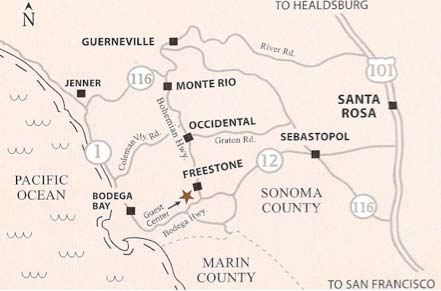
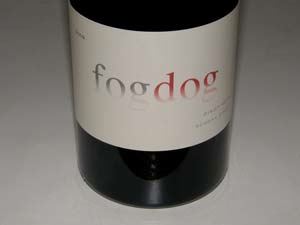 2009 Fogdog Sonoma Coast Pinot Noir 13.5% alc., 4,600 cases, $35. 100% estate grown that is approachable upon release. Aged 14 months in 35% new and 65% two to three-year-old French oak barrels. · Moderate garnet color in the glass. Lovely perfume of baking-spiced pie cherries. Light and crisp red cherry and red berry flavor with a slight confected tone, complimented by a subtle savory herbal element in the background, finishing with bright citrus-driven acidity. A lighter, soft and elegant wine designed for upfront drinkability. The combination of lower alcohol and refreshing acidity makes this wine a perfect dining companion. Good (+).
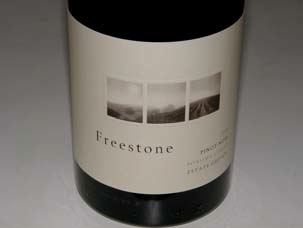 2009 Freestone Estate Grown Sonoma Coast Pinot Noir 13.5% alc., 4,660 cases, $55. From Pastorale and Quarter Moon Vineyards. Aged 15 months in 55% new and 45% two to three-year-old French oak barrels. · Moderately deep reddish-purple color in the glass. Subdued nose initially, picking up intensity over time in the glass offering a fresh blend of cherries and berries with a floral element in the background. Very impressive concentration, even sappy on the mid palate, with generous and expressive flavors of black cherries, black raspberries and Hoison sauce, lifted by hi-tone acidity, and caressed by gentle, ripe tannins. An impressive hedonistic style of wine with the right touch of acidity, a creamy mouth feel and admirable balance. Good approachability now but with excellent aging potential.
2009 Freestone Pastorale Vineyard Sonoma Coast Pinot Noir 14.1% alc., 270 cases, $75. A special selection from two special blocks planted to a Calera selection, one undergoing whole berry fermentation with partial whole clusters and the other 100% whole cluster fermented in an oak open-top tank. Aged 15 months in 70% new and 30% two to three-year-old French oak barrels. Both fermentations were gently macerated. · Moderately dark reddish-purple color in the glass. Complex nose of black pie cherries, spice, earth and brioche building in intensity over time in the glass. Delicious array of shy red and black fruit flavors that are layered and polished, accompanied by notable fruit tannins, and a bright cut of acidity on the spiced fruit laden finish. Leafy notes from stem inclusion add interest. Even better the following day from a previously opened and re-corked bottle. Warrants cellaring. Very good.
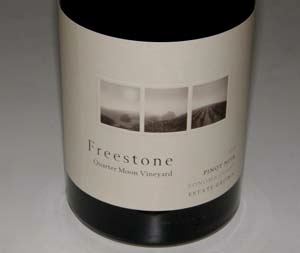 2009 Freestone Quarter Moon Vineyard Sonoma Coast Pinot Noir 13.5% alc., 390 cases, $75. Two special fermentations of 100% Calera selection fruit: one wine was whole cluster fermented in a small oak open-top tank and punched down by hand, while the other was whole berry fermented with 50% whole clusters added in a stainless steel tank without macerations for the first week, followed by one or two punchdowns per day until the desired texture was achieved. · Darkly colored in the glass. Enchanting aromas of black plums, dark berry jam, and Moroccan spice which come at you in waves over time in the glass. Full-bodied and shapely, with crisp fruit flavors of plum, black cherries and raspberries, framed by vibrant acidity, and wrapped in firm, ripe tannins. Softly textured and easy to like now, but not as expressive as it will be a few years down the line. Even better the next day from a previously opened and re-corked bottle with softer tannins and more intense extract. This wine will get noticed.
2009 Freestone Estate Grown Sonoma Coast Chardonnay 14.1% alc., 2,250 cases, $55. A mix of the best selections from the estate Pastorale Vineyard including some heirloom selections. 100% MLF. Aged 15 months in 55% new and 45% two and three-year-old French oak barrels. · Medium straw yellow color in the glass. Enticing and complex on the nose, showing aromas of spicy baked pears, toasted brioche, caramel, vanilla creme and toffee. Very tasty core of baked pears and apples with prominent notes of toast and caramel. Smooth on the palate with hi-strung acidity on the crisp finish. Plenty of oak-driven character in this wine. Good.
2009 Freestone Pastorale Vineyard Sonoma Coast Chardonnay 14.1% alc., 210 cases, $75. From the best block planted at Pastorale Vineyard and contains two heirloom selections. 100% MLF. Aged 16 months in 65% new and 35% two to three-year-old French oak barrels. · Light straw yellow color and clear in the glass. More reserved and sophisticated than the Estate Grown Chardonnay with aromas of white peaches, creme brulee, slate and parchment. Understated but alluring with layers of interest including flavors of baked apples, lemon meringue pie, and toffee with a special underpinning of minerals. Seamless, with great balance, finishing with a welcoming riff of citrusy acidity, urging on the drinker to take another sip.
Harrington WinesBryan Harrington crafts small lots of (never larger than 225 cases) artisan Pinot Noir and Nebbiolo from his urban winery warehouse located in the Produce District of San Francisco. Harrington wines are available for purchase from the website at www.harringtonwine.com and retailers in the San Francisco Bay Area. Occasional winery open houses are scheduled.
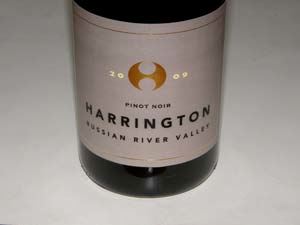 2009 Harrington Russian River Valley Pinot Noir 14.2% alc., pH 3.59, TA .61, 104 cases, $40. Sourced from the Middle Reach area of northern Russian River Valley. The vineyard is family owned, 2-acre, and planted to Pommard clone. Aged 10 months in 25% new French oak barrels. · Moderately light reddish-purple color in the glass. Aromas of ripe Bing cherries, baking spices and smoky oak. Deeply flavored with very ripe dark cherries and accents of cola and mocha robed in ripe tannins and framed by a healthy acid spine. Appears to be from a very warm Russian River Valley site. Good (+).
2009 Harrington Mendocino (Wiley Vineyard Anderson Valley) Pinot Noir 14.1% alc., pH 3.59, TA 0.61, 48 cases, $40.Sourced from a vineyard planted to the Martini selection in 1968. A 2-acre block of this old vineyard was sold to developers 15 years ago and farming ceased. In 2008, this block was cleared of brush, pruned and an organic dry-farming program established. It is located on a stony, west sloping benchland at an elevation of 1,000 feet. Aged 10 months in 50% new French oak barrels. · Light reddish-purple color in the glass. Complex perfume of red fruits, wooded forest, mushrooms, spice and seasoned oak. Soft and smooth on the palate with a light weight array of red berries and cherries with a savory hint of herbs. A little rustic with mild tannins and vibrant acidity. A gentle wine for current drinking. Good.
2009 Harrington Paso Robles Nebbiolo 14.1% alc., pH 3.14, TA 0.715, 100 cases, $30. From two Templeton Gap vineyards (Luna Matta and AJB) planted in calcareous soil and sand, much like the hillside slopes of Italy’s Barolo and Barbaresco wines. Aged 16 months in neutral French oak barrels. · Moderately light in color in the glass. Aromas of humus, underbrush and resin with delicate red fruits in the background. A delicate core of red cherries and berries is wrapped in aggressive tannins and lemony acidity which provides a mouth-puckering finish. Decent.
Hop Kiln WineryHop Kiln Winery dates to 1976, having spawned many well-known winemakers. The current owner is Vero Westside Joint Venture. Proprietary blends, bottled under the Hop Kiln label (Thousand Flowers and Big Red) make up a large part of Hop Kiln’s current production, but in 2004 a line of premium estate grown wines were introduced under the HKG (Hop Kiln Grown) label including a Pinot Noir. Most of the 248-acre property was replanted with Pinot Noir (44 acres), Chardonnay (16 acres) and Pinot Grigio (6 acres) beginning in 2009. The winemaker is Chuck Mansfield who has a degree in enology and viticulture from Cal Poly San Luis Obispo and studied advanced viticulture in Australia. The wines are sold through the winery website. The tasting room at 6050 Westside Road in Healdsburg is open daily and a second tasting in Glen Ellen is open Thursday through Sunday. The website is www.hopkilnwinery.com.
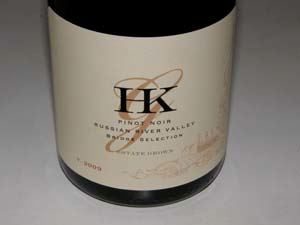 2009 HKG Estate Bridge Selection Russian River Valley Pinot Noir 13.9% alc., pH 3.66, TA 0.541, 450 cases, $38. Multiple clones including 114, 777, 828, Jackson 29, Pommard 4 & 5, and Comar 538. Aged ten months in 40% new French oak barrels. Inaugural bottling with un-racked barrels chosen for inclusion. · Moderate reddish-purple color in the glass. Bright aromas of Bing cherries, baking spices, red licorice and oak vanillin. Medium weight flavors of slightly confected, fresh pie cherries with hints of cola and mocha. Soft and silky on the palate with supple tannins and welcome finesse. A harmonious wine that is comely in character and easy to drink. Very good (+).
Kendric VineyardsStewart Johnson farms the Kendric Johnson Vineyard on leased land at the boundary of the Marin County and Sonoma Coast appellations 8 miles west of the Pacific Coast. This 8.5-acre vineyard was planted in 2002 to clones 37, 115, 667, 777, 828, Pommard and Martini. Yields are extremely low at this very cool site. Stewart could well be the most educated winemaker in California. He graduated from University of California at Berkeley, obtained a doctorate in political science from Yale, and graduated with a law degree from Hastings. While interning at the Environmental Protection Agency, he was drawn to winegrowing and winemaking rather than being confined to an office practicing law. With his wife, who is a Marin native, he discovered the pastoral beauty of Marin County and ended up growing grapes there. I have tasted every vintage of Kendric Vineyards Pinot Noir since the inaugural 2004 release and found the wines to be consistently stellar and sensibly priced. The 2008 vintage is probably the best to date. Both vintages reviewed below are available on the winery’s website at www.kendricvineyards.com. Some fruit from the Kendric Johnson Vineyard is sent to other premium producers including Miller Wine Works and Sheldon (reviews below).
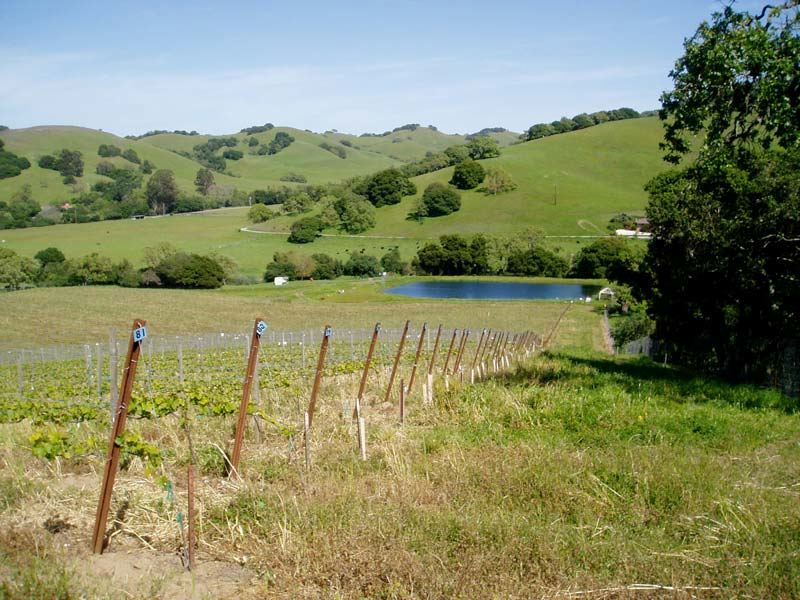
2007 Kendric Vineyards Marin County Pinot Noir 13.9% alc., 368 cases, $34. · Moderate red color in the glass. Scents of cherries, strawberries, spice and wine cave emerge slowly over time in the glass. Light to medium weight core of cherries with hints of sandalwood and black olive. Smooth in the mouth with an uplifting, mildly oak-tinged finish. Pleasant but not extraordinary. Good (+).
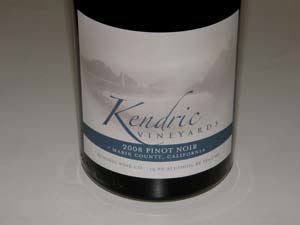 2008 Kendric Vineyards Marin County Pinot Noir 13.5% alc., pH 3.41, TA 0.59, 365 cases, $35. Yield 1.75 tons per acre. · Mildly intense dark red color in the glass. Subdued aromas of black cherries, vanillin and rose petals. Attention getting presence on the mid palate of dark red berries, blueberries, herbs and sassafras. A polished, engaging wine with supple tannins and bright acidity on the finish. Easy to drink now, but impeccable balance portends many years of good drinking ahead. Very good.
Sheldon WinesSheldon Wines is a partnership between Dylan Sheldon and Tobe Weatherly. The two met at the Cepage Wine Bar in Carmel, California, which Sheldon started in 2000 after working harvest in Western Australia. Weatherly was a geologist who frequented the wine bar. They were engaged five weeks after their first kiss, sold all their belongings, and traveled the world together making wine. When they returned to the United States, they leased an empty winery in Sebastopol and vinified their first 420 cases of Sheldon wine in 2003. The wines reviewed here are very uneven in quality. The Sheldon Wines tasting room is located in Santa Rosa’s Urban Winery Village (open Friday 4:00 to 7:00 and Saturday and Sunday 2:00 to 6:00 and by appointment). The portfolio includes a Rhone white blend, Petite Sirah, and Graciano. The wines are sold on the website (www.sheldonwines.com) with limited retail distribution.
2006 Sheldon Kendric Vineyard Marin County Pinot Noir 13.8% alc., pH 3.67, TA 0.70, 180 cases, $42, sold out. Clones 115, 667 and Pommard. About 20% whole clusters, cool fermentation, gently pressed to barrel, bottled unfined and unfiltered. · Moderate reddish-purple color in the glass. Secondary characters dominant the bouquet showing aromas of humus, moss, cigar box and old wood. Flavors of black cherries, plum, spice and stem are framed by vivid acidity and prominent dry tannins. Tastes like a 10-year-old Pinot. Decent.
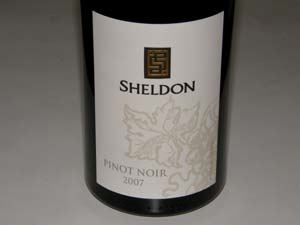 2007 Sheldon Marin County Pinot Noir 13.5% alc., pH 3.59, TA 0.52, 145 cases, $28. Clones 115, 667 and Pommard. 20% whole clusters, cool fermentation to retain aromatics, pressed to 20% new French oak barrels. Unfined and unfiltered. · Moderate reddish-purple hue in the glass. Glorious nose with engaging aromas of dusty cherries and berries, candied apple, earth and subtle oak. Delicious flavors of black cherries, black raspberries and spice finishing with a boatload of cherry flavor. Well-mannered fine grain tannins and refined acidity make for a cozy wine that is drinking perfectly now. Delivers plenty of pleasure while still remaining light on its feet.
2010 Sheldon Roma’s Vineyard Anderson Valley Pinot Noir 13.4% alc., pH 3.70, TA 0.60, 125 cases, $45. From a vineyard situated at 1,800 feet elevation at the deep end of the Anderson Valley. Pommard clone. One lot cold soaked, crushed and fermented in small, open-top fermenters without sulfur addition and the second lot was fermented whole cluster. Aged in two and three-year-old French oak barrels. · Moderate reddish-purple color in the glass. Very floral nose featuring violets and dried rose petals. Floral-tinged redder fruits with a mild confected tone in a relatively light weight style. The delicate fruit is overwhelmed by aggressive dry tannins and hi-pitched lemony acidity on the finish. Bland and out of balance. Unsatisfactory.
Pali Wine Co.Founded in 2005 by Tim Perr, Scott Knight and a group of investors, the winery is named for the Los Angeles suburb of Pacific Palisades where the principals live and work. Pali produces several single-vineyard Pinot Noirs from top notch vineyards in California and Oregon, a line of value-priced appellation blends of Pinot Noir and Chardonnay named for different neighborhoods in the Pacific Palisades, and a group of very inexpensive wines bottled under the Tower 15 label. At one point, the winery produced as many as ten single-vineyard Pinot Noirs, but this has been reduced in 2009 to two (and a Chardonnay from Shea Vineyard in Oregon) as the winery has shifted its emphasis to more affordable, earlier drinking wines. A modern winery was complete in Lompoc in 2007 and tasting is available there Fridays and Saturdays and other days by appointment (www.paliwineco.com. The wines are all bottled under screw top. The 2005 to 2007 vintages were vinified by Brian Loring. Aaron Walker is the current winemaker with Kenneth Juhasz (Auteur, Donum Estate, Dunstan) acting as the consulting winemaker.
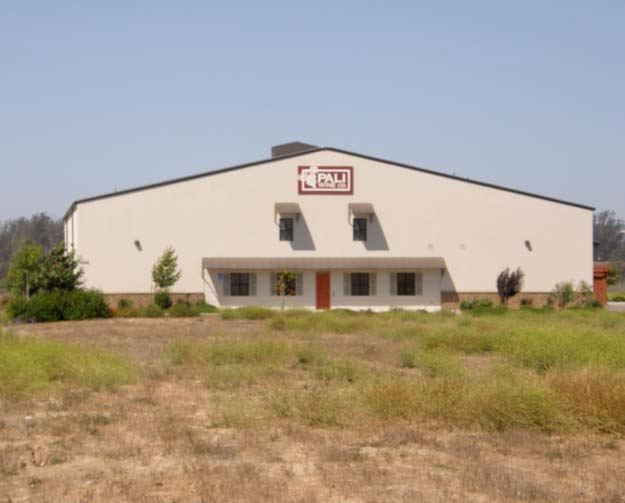
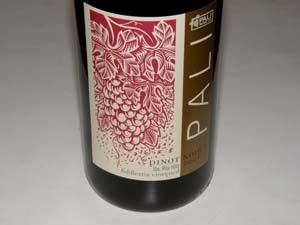 2009 Pali Wine Co. Fiddlestix Vineyard Sta. Rita Hills Pinot Noir 14.7% alc., 110 cases, $48, screw cap. Dijon 667, 777, 115 and Pommard 4 clones. Aged 15 months in 50% new French oak barrels. · Moderate reddish-purple robe. Deep aromas of very ripe, dark fruits with hints of oak-driven spice and vanillin. Intensely flavored with a big-boned core of very ripe blackberry, black raspberry and black current fruit framed by well-proportioned tannins which are unusually well-mannered for this vineyard. Soft and plush in the mouth with well-integrated oak and admirable persistence on the back end. Generous and fruity rather than classy or complex. Good (+).
2009 Pali Wine Co. Cargasacchi Vineyard Sta. Rita Hills Pinot Noir 14.8% alc., $48, screw cap. Dijon 115 clone. Aged 15 months in 50% new French oak barrels. · Medium red-purple color in the glass. The nose is primarily savory with aromas of humus, underbrush, oak spice and flowers. Rustic and earthy, with a mediumbodied core of dark raspberry and plum fruit that lingers on the relatively long finish which displays slightly cooked fruit and a floral tone. Still sporting notable ripe tannins that need time to fully integrate. Good (+).
Scribe WineryProprietor Andrew Mariani acquired 256 acres in 2007 three miles east of the Sonoma Town Square in Carneros. The property has a long and colorful history dating to 1858 when Emil Dresel and his brother Julius established vineyards on the site. They may have planted the first Riesling and Silvaner vines in the United States. There are reports of clandestine Prohibition era activities on the property and most recently, the land was home to turkeys. With partners Kristof Anderson and Andrew Avellar, the trio is revitalizing the property and growing 35 acres of Pinot Noir, Chardonnay, Riesling and Sylvaner. The first vines were established in 2008. Part of the large property is being designated as a “Forever Wild” Conservation Easement, which is protected for perpetuity under the Agricultural Preservation and Open Space District of Sonoma County. The current wines are crafted from purchased grapes from Carneros and a leased vineyard property in Napa. A winery is planned to preserve the turkey shed imprint and honor the history of the property. Membership in the Scribe Viticultural Society is worth considering not only for the wine but to gain VIP access to events at the Scribe Estate. Mariani has a group of San Francisco Bay area chefs as pals and they often show up at the estate holding forth at an outdoor kitchen and wood-fired oven. Tasting is by appointment (707-939-1858). Visit the informative website to sign up to receive the winery’s newsletter and to join the Scribe Viticultural Society.
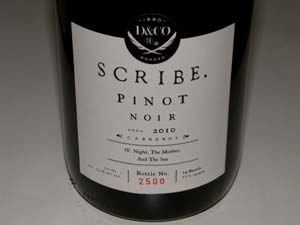 2010 Scribe Carneros Pinot Noir 13.1% alc., 350 cases, $42. Indigenous fermentation, aged 5 months in neutral French oak and bottled unfiltered. · Medium reddish-purple color in the glass. Effusive nose offering scents of Bing cherries, ripe raspberries, musk, cola and vanillin. A festival of cherry and dark red berry flavors with a slight exotic and confected bent. Plush on the palate with supple tannins and a hint of smoky oak in the background. A cozy wine that is nicely balanced and user friendly. Very good.
TalismanWinemaker Scott Rich crafts age worthy Pinot Noir from challenging and expressive sites. Along with his spouse, Marta, who is also the National Sales Manager for Calera Wine Company, Scott started his small label in 1993. Trained under Tone Soter at Etude in Carneros, Rich crafts small lots (typically 200 to 300 cases) of terroir-driven Pinot Noir at his small warehouse winery in the town of Sonoma. Although I admire the wines, you do not have to trust me: check out the many testimonials on the website at www.talismanwine.com. The wines are sold primarily through a mailing list. Tasting is by appointment (707-258-5722).
2008 Talisman Sonoma County Cuvée Pinot Noir 14.3% alc., pH 3.72, TA 0.62, 161 cases, $32. A multi-vineyard blend selected from single-vineyard lots. Barrels of both 2007 and 2008 vintages went into this blend. Dijon 115, 777, Pommard and Swan. Aged 20 months in French oak barrels. · Medium reddish-purple color in the glass. Very reserved aromatics offering hints of dark cherry compote and herbs. Earth-kissed flavors of black cherries and black raspberries clothed in mild ripe grape tannins and offering a refreshing cut of acidity on the finish. Still seems tight and I would decant if you open now. Soft in the mouth and easy to drink. Good.
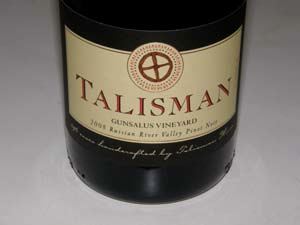 2008 Talisman Gunsalus Vineyard Russian River Valley Pinot Noir 14.3% alc., pH 3.78, TA 0.52, 296 cases, $40. Pamela and Glen Gunsalus farm their vineyard located in the Green Valley of Russian River Valley. Dijon 114, 115, 667 and 777. 25% whole clusters, native fermentation. Aged 20 months in 75% new French oak barrels. · Moderately deep reddish-purple color in the glass. Lovely perfume of fresh pie cherries, spice and herbs. Amazing depth of cherry and red raspberry flavor, accented with notes of sassafras and baking spices. Long and creamy on the palate, finishing with a burst of sweet cherry fruit flavor that sails along. The flavors trump the aromas now, but further bottle aging should remedy that. Flat out beautiful and a worthy followup to the spectacular 2007 bottling from this vineyard.
2008 Talisman Wildcat Mountain Vineyard Los Carneros Pinot Noir 14.3% alc., pH 3.75, TA 0.59, 184 cases, $45. Highest elevation vineyard in Los Carneros . An extreme, cool site exposed to the wind from San Pablo Bay. Red pebbly clay loam soils. Swan, Pommard, Dijon 115 and 777. Aged 20 months in 86% new French oak barrels. · Moderate reddish-purple color in the glass. A very divisive wine because of its feral and savory components. Aromas of wild strawberries, black cherries, spice and subtle ash. Silky on the palate with discreetly concentrated flavors of red cherries and berries with a hint of spice and truffle. Oak-driven smoke and tar are evident. Considerably better the following day from a previously opened and re-corked bottle with brighter and fruitier aromatics and less oak-driven attributes. Good (+) but may warrant a higher recommendation in a few years as the high percentage of new oak becomes better integrated into the wine.
Thomas George EstatesThis winery has made remarkable strides in the past four years. The former Davis Bynum Winery and estate vineyards were acquired by the Baker family of Toronto, Canada in 2007. Jeremy Baker has directed the renovation of the winery, the construction of a crush pad, a new tasting room, replanting of estate vineyards including the estate Baker Ridge Vineyard adjacent the winery, and the construction of 8,000 square feet of barrel aging caves (the only caves on Westside Road). The Bakers purchased the Starr Ridge Vineyard on Windsor Road and the Cresta Ridge Vineyard in the Green Valley appellation, both originally planted and farmed by Gary Farrell and both premium sources of Pinot Noir and Chardonnay, expanding their Russian River Valley estate program to 63.5 acres. The vineyard manager is noted Sonoma County viticulturist, Ulises Valdez, who works closely with renowned vineyard consultant Bob Gallagher of Crop Care Associates. Winemaker Chris Russi, like Jeremy, is young and energetic and the wines he has crafted have made huge strides since the new winery was completed in time for the 2008 vintage. Multiple varietals are offered from top vineyard sources in Sonoma County to compliment the winery’s focus on site-specific Pinot Noir and Chardonnay estate wines. The house style emphasizes lower alcohols, excellent acidity and the modest use of new oak. I am impressed by the progress made with each recent vintage and the consistent high quality across the winery’s whole range of Pinot Noirs, white wines and sparkling wine in 2009. The winery’s beautiful setting off Westside Road is the site of many events including weddings. The tasting room is well appointed and open daily. The wines are made available on the informative website at www.thomasgeorgeestates.com. Guesthouses on the property are available for rent to complete the full visitor experience.
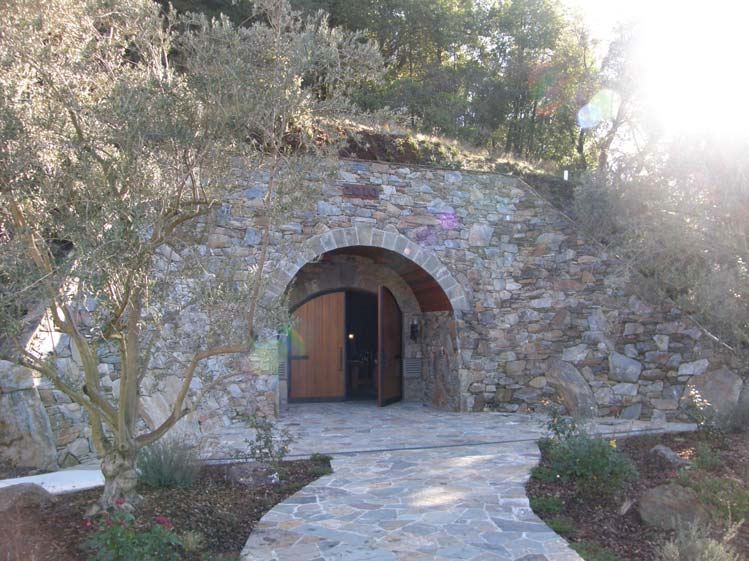
2009 Thomas George Estates Russian River Valley Chardonnay 14.6% alc., pH 3.41, TA 0.60, 740 cases, $34. A blend from Cresta Ridge and Starr Ridge vineyards (78%) and Floodgate Vineyard (22%). Whole cluster pressed and racked to 90% French oak barrels (20% new) and 10% to stainless steel drums. MLF was inhibited at 30%. The lees were stirred for the first four months, then allowed to settle. · Light straw color and clear in the glass. Aromas of lemon curd, biscuit, cut grass, and lees. Bright flavors of baked pear, lemon peel, and marzipan. A solid wine that will work nicely as an aperitif or a companion at the dinner table. Good (+).
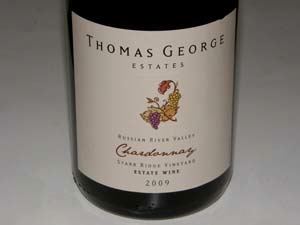 2009 Thomas George Estates Starr Ridge Vineyard Russian River Valley Chardonnay 14.6% alc., pH 3.38, TA 0.62, 345 cases, $38. A blend of clones 95 and 96. Fermented in 100% French oak barrels (20% new) with lees stirring for four months. MLF inhibited at 20%. · Light straw yellow color in the glass. The nose is clean and pure, with a perfume of baked apple pie, crushed wet stones and a hint of caramelized oak. Refined and smooth on the palate, with a flavor core of pears, baking spice, cocoa powder, roasted almonds and a touch of grapefruit peel on the finish. A refined, sophisticated offering. Very good.
2009 Thomas George Estates Windsor Oaks Vineyard Russian River Valley Sauvignon Blanc 13.8% alc., pH 3.30, TA 0.68, 465 cases, $25. A warm site in the eastern portion of the Russian River Valley. Whole cluster pressed, fermented cold for three weeks, racked off the lees and aged in stainless steel until bottled. No MLF. · Light yellow color in the glass. Aromas of grilled peaches, lemon custard, and new mowed hay. Very engaging on the palate with flavors of apple, white peach, citrus, gooseberry and vanillin. Slightly creamy with faint tannins and a dry finish sporting a lively cut of acidity. Very good.
2009 Thomas George Estates Saralee’s Vineyard Russian River Valley Pinot Blanc 14.0% alc., pH 3.2, TA 0.63, 190 cases, $27. Hand harvested and whole cluster presserd to tank, fermented cold for 17 days. Racked off the lees and aged in stainless steel until bottled. No MLF. · Straw yellow color in the glass. I enjoyed this wine for its restraint and charm. It offers an array of aromas and flavors including baked apple, pear, honey, and hazelnuts. A tiny bit of tannin gives the wine traction and the finish is crisp and refreshing. Good (+).
2009 Thomas George Estates Russian River Valley Estate Pinot Noir 14.3% alc., pH 3.84, TA 0.587, 1,280 cases, $40. A blend from the three estate vineyards featuring clones 777, Pommard, 114 and 115. 100% de-stemmed, 16 day fermentation with daily punch downs, tanks drained and skins pressed via a basket press, aged on the lees for 11 months in 31% new French oak barrels. · Moderately deep reddish-purple color in the glass. Glorious aromas of Bing cherries, black raspberries, spice and complimentary toasty oak make you want to hug the glass. Medium weight flavors of black cherry and cola with a touch of clove offer plenty of intensity, yet the wine remains light on its feet. Nicely balanced with impressive length on the finish. The epitome of Russian River Valley Pinot Noir.
 2009 Thomas George Estates Baker Ridge Vineyard Russian River Valley Pinot Noir 14.4% alc., pH 3.65, TA 0.60, 186 cases, $60. From 8 acres of older block planted over 20 years ago. Four clones on three different exposure and soil sites. 100% de-stemmed, monthly batonage for first six months. Aged 11 months in 37% new French oak barrels. · Moderately deep reddish-purple color in the glass. Subdued but pleasing aromas and flavors of dark red cherries and berries, nicely spiced and highlighted with subtle toasty oak. Not as extracted as the Russian River Valley blend, but more seductive with subtle layers of flavor slowly revealing themselves over time in the glass. Impressive finishing strength and length. Much better later in the day from a previously opened and re-corked bottle and still great two days later. Decant if you pull the cork now. A feast.
Wild Horse Winery & VineyardsMany consumers associate Wild Horse with the ubiquitous, entry level and reasonable priced Central Coast Pinot Noir seen on practically every supermarket wine department shelf. There is, however, more Wild Horse wines to explore that are worthy of a serious pinotphile’s interest. Wild Horse Winery has been part of the Central Coast wine landscape for over 30 years, having been originally founded by Central Coast winemaker icon, Kenneth Volk, in 1981. In 2003, the winery was sold to Peak Wines International and then sold to Constellation Brands. Currently, Wild Horse sources grapes from over fifty vineyards throughout California’s Central Coast. There are three levels of Wild Horse Pinot Noir: Wild Horse Wines (inexpensive, early drinking, widely distributed), Unbridled Wines (limited production releases, often only available at the winery), and Cheval Sauvage (a reserve wine selected from special barrels). Cheval Sauvage (French for “Wild Horse”) is sourced from several coveted vineyards on the Central Coast and represents a premium blend of Pinot Noir clones that varies with each new vintage. The current 2008 vintage includes fruit from Garey, Bien Nacido, Addamo and Sierra Madre Vineyards in the Santa Maria Valley, and Rancho Los Hermanas Vineyard in the Santa Rita Hills. The winery and tasting room are located south of Paso Robles in Templeton. Visit the website at www.wildhorsewinery.com to purchase wines.
 2008 Wild Horse Cheval Sauvage Santa Maria Valley Pinot Noir 14.5% alc., pH 3.49, TA 0.572, $60. A finest barrel selection. Small lot, whole berry fermentation in open-top fermentation bins with manual daily punch downs. Only the finest barrels are selected for this bottling. Aged 14 months in French oak barrels. · Moderate reddish-purple color in the glass. Nicely perfumed with vivid aromas of black cherries, spice and Italian herbs picking up intensity over time in the glass. The medium weighted flavors of dark stone fruits and berries combined with savory herbs and the slightest oak are framed by svelte, satiny tannins and good acidity to produce a wine of considerable charm. I particularly enjoy this wine for its savory bent, elegance, balance, and unmistakable sense of Santa Maria Valley terroir. Definitely worth seeking out.
Mueller Winery: Quintessential RRV Middle ReachOwner Bob Mueller has had a distinguished winemaking career. After receiving a bachelor’s degree in biology at the University of California at Santa Cruz, he worked at Paul Masson Champagne Cellars in Saratoga as a chemist where he made the decision to become a winemaker. After earning his masters degree in food science and enology at University of California at Davis, he became the winemaker at both Foppiano Winery and Charles Krug Winery, and was later hired as senior winemaker at Pirelli-Minetti Winery in Delano, California where he directed three winemakers in the crushing of more than 25 million gallons of table wine, sparkling wine and brandy annually. After a stint as winemaker at Souverain Winery in Geyserville, Bob (pictured below) left to start his own consulting business and designed and established a large custom crush facility in Geyserville.
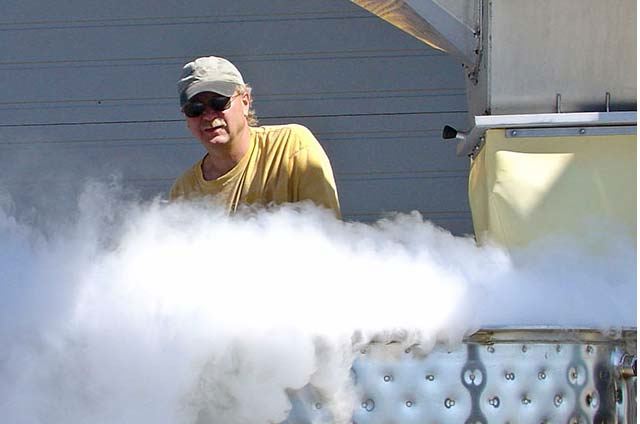 In 1991, he established Robert Mueller Cellars in Healdsburg. His first Pinot Noir, “Emily’s Cuvée,” debuted in 1994. Ten years later, he built a winery on Starr Road in Windsor and gradually ramped up production to its current 4,000 to 5,000 case level. The winery is largely a one-man operation, with Bob handling all the cellar and production duties, while his wife, Lori, handles sales, accounting and compliance work. Mueller is best known for Pinot Noir, but also produces Chardonnay, Sauvignon Blanc, Old Vine Zinfandel and Syrah, all sourced from the Russian River Valley. The 2008 vintage of Mueller Pinot Noir has been highly lauded and all six of the wines received high scores from the Wine Spectator. Several of the wines reviewed below have already sold out. Pinot Noir is sourced from Vino Farms vineyards located near the banks of the Russian River Valley off of Eastside Road. Tasting is available in the Mueller winery cellar Friday through Sunday from 11:00 to 4:00 at 6301 Starr Road. The wines are also sold through the website store ( www.muellerwine.com). The Russian River Valley and Emily’s Cuvée Pinot Noirs are in limited retail distribution. The Mueller Pinot Noirs are flashy, lush, extravagantly fruity wines showing the bright cherry and cola flavors and moderately high alcohols that are the hallmarks of warmer Russian River Valley vineyard sites. That said, the fruit is never over ripe or jammy and there is enough acidity in the wines to keep them juicy. Grapes are picked at about 25.0 Brix at harvest, 100% de-stemmed, fermented in 2-ton custom fermenting tanks using both indigenous and inoculated yeast, and subjected to punch downs by hand several times a day. The wines are racked to barrel and aged in 30% to 40% new French oak.
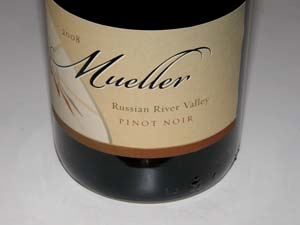 2008 Mueller Russian River Valley Pinot Noir 14.9% alc., 510 cases, $29 (sold out - 2010 vintage to be released in December 2011). Dijon clones grown near the banks of the Russian River. · Moderately light reddish-purple color in the glass. Bright and fresh in the glass with vibrant aromas of Bing cherries and baking spice. Discreetly concentrated core of sweet dark cherry fruit with some mild oak-driven flavors of biscuit and smoke. Leaves a satisfying cherry memory on the crisp finish. Much better the next day from a previously opened and re-corked bottle. A cherry jubilee. Very good.
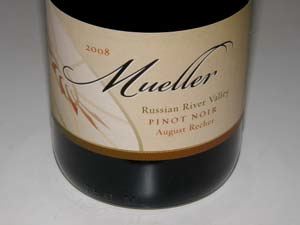 2008 Mueller August Recher Russian River Valley Pinot Noir 14.9% alc., pH 3.60, 223 cases, $39 (sold out; available as part of the “Pinot Quartet”). Dijon clones 667 and 777. · Medium reddish-purple color in the glass. Amazingly fragrant with a perfume of cherry essence and complimentary oak spice. A delicious cherry bombast coats the tongue accompanied by accents of cola, Asian 5-spice and dark chocolate-covered cherries. The tannins are very supple and there is enough acidity to bring the fruit into focus and retain a refreshing tone. Amazingly persistent on the finish. In the words of sportscaster Keith Jackson...”Whoa, Nellie.”
2008 Mueller Cuvée X Russian River Valley Pinot Noir 14.9% alc., pH 3.60, 207 cases, $39. From a selected vineyard block of Martini 15 clone located at Saralee’s Vineyard on Slusser Road. · Moderately light reddish-purple hue in the glass. Brooding aromas of black cherries and exotic spice. Moderately rich core of sweet black cherry fruit with undertones of cola and oak vanillin. Seamless, silky and elegant in the mouth with pillowy tannins. The wine shows a slight tarry note that is presumably from oak and dissipates in the glass over time. Showing more aromatic interest the following day from a previously opened and re-corked bottle indicating the wine needs a year or two in the cellar. Very good.
2008 Mueller Eastside Russian River Valley Pinot Noir 14.9% alc., pH 3.60, 217 cases, $39. Dijon clones 667 and 115 and Wädenswil 2A. · Moderate reddish-purple color in the glass. Reserved aromas of spiced dark red cherries and berries, woodshed and forest floor. Crisp and juicy, flush with red cherry flavor that is accented with notes of sandalwood and spice, offering bright acidity, fine-grain tannins and a seductive elegance. Easy to drink now and like Drew Barrymore - very successful at a young age.
2008 Mueller Tempi Russian River Valley Pinot Noir 14.9% alc., pH 3.60, $39. From a select vineyard block of Dijon 777 clone at a well-drained, gravely site that is part of Vino Farms. · Moderately light reddish-purple color in the glass. Very reserved aromatics offering demure aromas of confected cherries and oak. Impressive array of very ripe dark red stone fruit and strawberry flavors with a prominent cola presence on the mid palate, finishing with a slight leafy quality and a rush of fine-grain tannins. Better aromatics the following day from a previously opened and re-corked bottle showing noticeable spice and more vibrant fruit. Needs time to integrate the tannins. Good (+).
2008 Mueller Emily’s Cuvée Russian River Valley Pinot Noir 14.9% alc., 772 cases, $44. From a vineyard site farmed by Jim Ledbetter (Vino Farms) one mile from the Russian River and directly across the river from Rochioli and Allen vineyards in the Middle Reach of the appellation. · Moderate reddish-purple color in the glass. Aromas of black cherries and toasty oak building in intensity in the glass over time. Generous core of ripe black raspberry and black cherry fruit with a hint of herbs, and a subtle citrus underpinning. Wellmannered soft tannins create a smooth ride, leading to a moderately intense fruit-driven finish that leaves a little heat in its wake. Good (+).
Antica Terra Estate: A Place for DreamersIt is a proud time for winemaker Maggie Harrison for it has been over six years since the spring of 2005 when she first visited Antica Terra in the Eola-Amity Hills and contemplated making the move to Oregon from her comfortable assistant winemaking position at Sine Qua Non. When she visited Antica Terra on that first spring day, her memories remain vivid. “From that viewpoint I could feel the peculiar quality of light that I now recognize as intrinsic to the place. The clouds seem to fracture over the vineyard and allow the sun to ray through, at an angle and with an intensity that makes the site feel bright, even on the bleakest day. I could see the vineyard; a sea of yellow leaves and stunted shoots. The vines were at the beginning of their growth cycle, but they were already beginning to defoliate. There were piles of black plastic and rotting hay in all the rows; remnants of a failed attempt at experimental weed control. It had done little more than create the perfect habitat for voles intent on girdling the vines. I could also see the picnic table under the old oak tree where we had just tasted the wine that they made from the site in 2003. It seemed inconceivable that such an intense, concentrated and utterly unique liquid could have emerged under these meager conditions. The site was so beautiful, the potential so clear, and the suffering equally clear. In that moment, looking at the vineyard from a distance, at the top of the forest where everything seemed so small, I felt like it was a situation I could wrap my arms around. I knew that I could do the work, concrete and real, to heal the place and make the wines this land was capable of.”
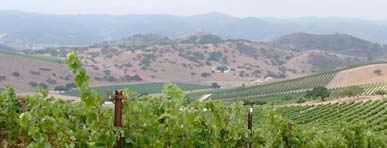 In the fall of 2005, all the wine produced from the site was declassified and another source for grapes had to be found to produce Antica Terra Pinot Noir over the next several vintages while the vineyard was undergoing rehabilitation. Antica Terra was fortunate to be able to obtain fruit from Shea Vineyard in an amount to equal what was planted at Antica Terra. The fruit from the two sites seemed to compliment each other. Maggie notes, “The old vine fruit from Antica Terra provides singularity and a smoldering complexity, while the grapes from Shea Vineyard bring fruit and stability.” The blend, which also included fruit from a third vineyard, turned out to be perfect. The Antica Terra fruit formed the core of the Willamette Valley bottling, giving it identity and complexity, but leaned on the fruit from other vineyards for completeness. The idea of bottling Antica Terra as a single-vineyard Pinot Noir was far from her mind. In 2008, an additional five acres of Pinot Noir were planted on the steep hillside site. The land turned out to be extremely rocky and three thousand tons of rock had to be removed to plant the vineyard. The vines struggled in the shallow, rocky soil. Maggie notes, “A sensible person would never choose to plant vines at Antica Terra. It is a hillside better left to the oaks; a place for dreamers, not viticulturists.” Nevertheless, hope springs eternal, and by 2009, portions of the vineyard remained healthy deep into the fall. In the spring following the 2009 harvest, Maggie and her partners began tasting the wines and were surprised by their intensity. Seven barrels containing wine grown on the site were set aside. Maggie recalls, “It was a surprise in the truest sense. We began this venture with the dream of making this wine firmly in our minds. Somewhere along the line, obsessed with all the intricate details of daily life, we forgot that this possibility existed. It was in this state of forgetfulness, when we were least expecting it, that it emerged.” 164 cases of 2009 Antica Terra Vineyard Estate Pinot Noir culminated a six year project of hope and dedication. Antica Terra wines are offered through a member mailing list at www.anticaterra.com. In 2009 the lineup of wines include the inaugural Chardonnay made from Bethel Heights old vine fruit and clone 76 from Johan Vineyard. The Antica Terra Rosé, “Erratica,” is my favorite rosé produced in Oregon. The three Pinot Noirs include the Willamette Valley bottling (fruit from the Antica Terra estate and two extreme sites closer to the coast), Botanica (a Reserve blend), and the Estate Grown Antica Terra Vineyard wine.
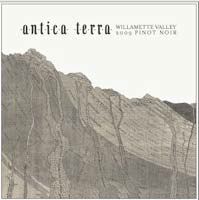 2009 Antica Terra Willamette Valley Pinot Noir 13.5% alc., $50. Released April 2011. · Moderate reddish-purple color in the glass. Black cherry and black raspberry is at the heart of this wine which displays prominent oak-driven aromas and flavors of roasted coffee beans and mocha java. Moderately rich with supple tannins, the wine can be enjoyed now, but will benefit from more time in bottle to allow the oak to further integrate. Good (+).
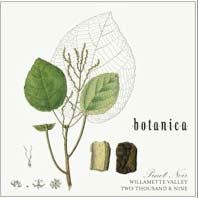 2009 Antica Terra Botanica Willamette Valley Pinot Noir 15.0% alc., $75, wax closure. Released April 2011. Unusual ripeness for Willamette Valley fruit reminiscent of the 2006 vintage in Oregon. A blend of fruit from Antica Terra Estate, Shea Vineyard and Stephen Hagen’s vineyard near Junction City. · Moderate reddish-purple hue in the glass. Demure aromas of very ripe strawberries and berry triffle. Medium-weighted flavors of ripe, sweet, dark red fruits wrapped in soft fine-grain tannins, leaving a lingering impression of lush fruit on the finish. Seamless, with a very sensual mouth feel, displaying well-integrated oak. A black tie, fruit-driven wine that is California in spirit. One would never guess this wine had 15% alcohol because it has the necessary fruit, acid and tannin to keep the wine in balance with the alcohol. It is not my favorite style of wine, but I have to admit finding it enjoyable. Very good.
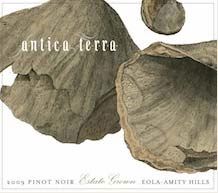 2009 Antica Terra Estate Grown Eola-Amity Hills Pinot Noir 13.6% alc., $100, wax closure. Released November 2011. · Moderately dark reddish-purple color in the glass. An engaging Pinot Noir with gorgeous perfume of wild berries, Christmas spices, mesquite, underbrush and coffee. The allure carries through on the palate with layers of flavorful dark berries, savory additions of leaf and spice, an exotic note of musk, and a complimentary underpinning of smoky oak. Impeccably balanced and very sensual in the mouth. A beautiful food wine. Even better the next day from a previously opened and re-corked bottle. If this Pinot were a lover instead of a wine, it’s one that would make you abandon your family, leave your job, and forfeit your hard-won position in the community for just one more fling.
White Rose Estate: Simply Stunning PinotWhen Greg Sanders bought the 9.5-acre White Rose Vineyard in the Dundee Hills of Oregon in 2000 he wanted to produce Pinot Noir from this now 20-year-old site that mimicked Burgundy’s top Grand Crus. He spent a considerable amount of money acquiring and tasting fine Burgundy to understand his goal, and I was lucky enough to tag along and taste some of the iconic wines of Burgundy with him. Greg has no formal winemaking experience beyond a few courses at University of California at Davis and does not drink which makes his story even more intriguing. His first wines were flawed with Brettanomyces. He initially chose to use very curious and oblique names for his wines including Dragon’s Bluff and Quotee’s Lair. A local well-known wine retailer in Southern California refused to carry Greg’s early wines because the retailer disliked the peculiar black and white labels.
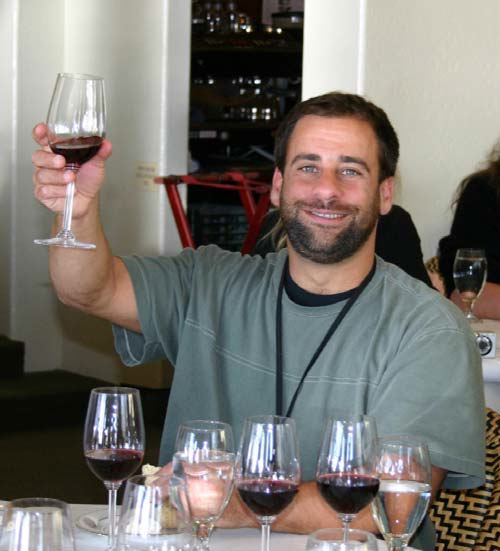 Since 2008, there has been a remarkable transformation at White Rose Estate. Greg now works in tandem with Jesus Guillen, also a largely self-taught winemaker whose father managed the estate since arriving in 2002. The labels have taken on a new design more fitting the quality of the wines and the website has been thoroughly upgraded. Wine Advocate reviewer Jay Miller said recently, “Old vines, low yields, and a willingness to stretch the envelope have made White Rose Estate one of the premier producers of American Pinot Noir,” and he gave the 2009 White Rose Vineyard Whole Cluster Pinot Noir a score of 96 points, the top scoring Oregon wine of the vintage. Two 2008 White Rose Estate Pinot Noirs made my 2010 Oregon Pinot Noir All-Americans First Team list. White Rose Estate now has a reputation befitting the neighborhood, with Domaine Drouhin Oregon, Domaine Serene and Archery Summit all close by. When I spoke with Greg recently, I asked him about the remarkable improvement in the wines beginning in 2008. He told me that it just took several years to dial in the style he was aiming for. He has veered away from the use of large amounts of new oak, now preferring about 10% during elevage. Greg uses a significant amount of whole cluster because he feels it adds more secondary character to the wines from his site. He began experimenting with whole cluster fermentation in 2004 and he found this “allows us to produce wines with full structure, allowing the complexity, density and purity of fruit to shine, and offering a clear expression of each layer of flavor.” By the 2011 vintage, all of Greg’s wines will be vinified with 100% whole cluster. Because of White Rose Vineyard’s relatively high elevation (720 to 870 feet above sea level), extended hang times are the rule and Greg’s wines have benefited from the extended growing season at the site. Over the last four years, harvest has occurred in late October and in 2011, stretched from October 25 to November 6. This allows for slow, ideal flavor and phenolic development, balanced sugars and acids, and mature stems. The White Rose Vineyard was planted between 1978 and 1982 and contains own-rooted Pommard clone. It is planted on an east-southeast facing slope of volcanic Jory soil. In 2009, an additional 4 acres of vineyard immediately north of the original site was acquired. This vineyard was planted in 2001 to Dijon 115 grafted to American rootstock and is showing more potential each year. For a number of years White Rose Vineyard fruit was sold to prominent Willamette Valley wineries such as Panther Creek, St. Innocent and Torii Mor, and was often bottled as a vineyard designate. Beginning three years ago, all White Rose Vineyard fruit is kept for estate bottlings. In addition, fruit is sourced from growers in the Yamhill-Carlton District AVA, Dundee Hills AVA and Chehalem Mountains AVA and bottlings are offered in 2009 from each of these three appellations and the Willamette Valley appellation. The estate Pinot Noir wines include White Rose Vineyard, Winemaker’s Cuvée, “Guillen,” “Hand Select,” and “Whole Cluster.” For 2009, yields averaged 1.5 to 1.75 tons per acre across all vineyard sites. The winemaking regimen for the estate Pinot Noirs is as follows. Fruit is typically cold soaked for 4 to 5 days before inoculation. 7 to 11 days of post-maceration skin contact follows the completion of fermentation. After 20 to 22 days of skin contact, the must is pressed off using an old world basket press and barreled down in French oak for 15 months of aging in the cellar. While in barrel, the wines are racked once after malolactic fermentation and then again just before blending. The 2009 White Rose Estate wines do not have quite the startling intensity of flavor and structure of the 2008 vintage wines, but they are more approachable upon release and are very classy wines in their own right. Greg has built an unusual tasting room with a small winery underneath whose main doors look out on to the Willamette Valley and Mt. Hood. The tasting room at 6250 NE Hilltop Lane in Dayton is open daily. Tours are available by reservation on Saturdays. The wines are sold through a mailing list, wine club and on the website (www.whiterosewines.com), with very limited retail distribution of some wines.
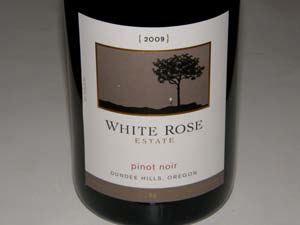 2009 White Rose Estate White Rose Vineyard Dundee Hills Oregon Pinot Noir 13.8% alc., pH 3.78, 308 cases, $70. 60% whole cluster fermentation. Sourced from the four oldest blocks of the vineyard. Aged 15 months in 8% new Rousseau oak barrels. · Moderately light reddish-purple color in the glass. Glorious nose offering aromas of cherry pie just out of the oven, baking spice, and potpourri. The palate is long and elegant, featuring waves of dark cherries and magic spice with well-mannered dusty tannins and perfectly matched acidity. Spectacular the next day from a previously opened and re-corked bottle. A very classy wine that speaks of low yields and old vine fruit.
2009 White Rose Estate Winemaker’s Cuvée Willamette Valley Oregon Pinot Noir 13.7% alc., pH 3.70, 48 cases, $70. 60% whole cluster fermentation. Winemaker Jesus Guillen’s favorite barrels: 1 barrel from Block 1 of White Rose Vineyard and 1 barrel of Bell Road Vineyard in the Chehalem Mountains. Aged 15 months in 100% neutral oak. · Moderately light reddish-purple color in the glass. Pleasing aromas of dark stone and berry fruits including marionberry, sassafras and a hint of herbal oak. The intense plum and dark red berry flavors arrive with conviction on the mid palate and persist on the finish. Silky smooth in texture with impeccable balance, this wine is still unevolved and linear, and will benefit from a couple years in the cellar. Very good.
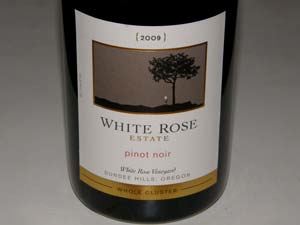 2009 White Rose Estate White Rose Vineyard Whole Cluster Dundee Hills Oregon Pinot Noir 14.0% alc., pH 3.72, 124 cases, $90. White Rose Vineyard Block 1, 100% whole cluster. Aged 15 months in 100% neutral French oak. · Moderately light reddish-purple hue in the glass. This wine really grabs your attention with a festival of ripe and forward aromas and flavors including dark pie cherries and sexy spice. Upon entry, the wine jolts your taste buds to action, offering substantial pleasure while displaying a seductive charm that carries over to the long and silky, cherry-soaked finish. Still mildly reserved, this marvelous juice should improve effortlessly over the next three to five years, and drink well for another five to ten years beyond that. Pick any superlatives you wish: my choice is “libidinous.”
Morning Dew Ranch Pinot Noir from Burt WilliamsThe list of admirers of winemaker Burt Williams reads like a who’s who of New World Pinot Noir producers: Bob Cabral (current winemaker at Williams Selyem), Michael Browne (Kosta Browne), Steve Doerner (Cristom Vineyards), Ted Lemon (Littorai), George Levkoff (George Wines), Tim Olson (Olson Ogden Wines), Manfred Krankl (Sine Qua Non), Jeff Fink (Tantara), Craig Brewer (Brewer-Clifton), Tom Dehlinger (Dehlinger), Chris Whitcraft (Whitcraft), Tom Rochioli (J. Rochioli Vineyards & Winery), Michael Sullivan (Benovia), Denise Selyem and Kirk Hubbard (WesMar), Ben Papapietro (Papapietro Perry), Nicolai Stez (Woodenhead), Ross Cobb (Cobb Wines), Mac McDonald (Vision Cellars), Guy Davis (Davis Family Vineyards) and Thomas Rivers Brown (Rivers-Marie). The are hundreds of other winemakers who have never met Williams, but have drank his wines and revere him. Williams was among the very first California Pinot Noir producers who demonstrated that great wine, and in particular Pinot Noir, could be produced without artifice. Technological methods such as saignée, alcohol adjustment, addition of Rubired and other extracts, or other products to change color, flavor, acid, tannin and mouth feel were shown to simply not be required or desirable. Although technology and expensive equipment can be useful winemaking adjuncts, Williams showed that they are not requirements for fine wine production.
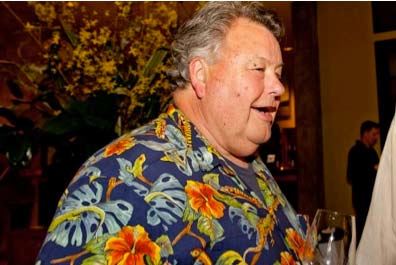 After Williams Selyem winery was sold in 1997, Williams bought a 40-acre property in the “deep end” of the Anderson Valley and planted 13 acres of Pinot Noir. Williams had searched for appropriate cool climate winegrowing sites including the Freestone area of the Sonoma Coast, but settled on the Anderson Valley, in part because the land was more affordable. Under the direction of viticulturist Steve Williams (no relation), the land was cleared and planted in 2000 to cuttings from the Rochioli vineyard, DRC suitcase selections from adjacent vineyards, clone 23 (Mariafeld - a clone Burt’s son favored), and Dijon clones 115, 777 and 828. The vineyard, named Morning Dew Ranch, had Franciscan soils, clay underlain with sandstone. The vines were irrigated to establish them initially, with limited irrigation used when required in certain vintages to fully ripen the fruit. Grapes from Morning Dew Ranch have been released as a vineyard-designated Pinot Noir by Brogan Cellars (owned by Burt’s daughter, Margi Williams-Wierenga), Woodenhead, and Whitcraft. Williams crafted small amounts of Pinot Noir from his vineyard in 2008 and 2009 after his ten-year non compete agreement had expired at Williams Selyem. The 2008 vintage was released this year to a small number of lucky customers (some wine is still available as of the publication date of this newsletter - e-mail me for contact information to obtain the 2008 PInot Noir), and the 2009 vintage will be released in 2012. Williams has no plans to produce wine after the 2009 vintage, choosing instead to enjoy his much-deserved retirement. The 2008 Pinot Noir was a selection of three blocks, each a different clone. 25% whole clusters were used with the rest of the grapes de-stemmed. Fermentation was carried out in open-top stainless steel tanks for 12 days, gravity racked and pressed to new French oak barrels. The wine was raised for 15 months on the gross lees before being racked to a tank for bottling. The wine was never pumped, fined nor filtered. Williams’ notes on the wine: “The vintage and terroir are both present in this wine as they have been in all my wines. There is initially a smoky aroma that combines with a dark berry fruit component with hints of roasted nuts and earth, medium rich palate, ripe tannins and berries on the finish. To sum this wine up in a more poetic vein, ‘the veil of the vintage present as it should be does not obscure the strength of the terroir.’ My suggestion with this wine is to decant it for aeration to allow the smoky components to recede a bit, and allow the fruit to come forward showing berry and pie cherry complexities. The wine at all stages pairs well with grilled salmon, lamb, veal and pork.
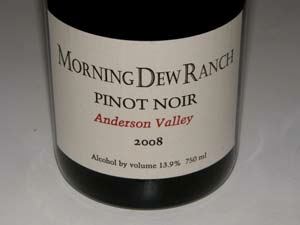 2008 Morning Dew Ranch Anderson Valley Pinot Noir 13.9% alc., 197 cases, $60. · Medium reddish-color in the glass. After decanting, aromas of pie berries, sweet barbecue smoke and wood spice emerge. Very fresh and vivid dark red berry fruit display an increasing charm over time in the glass and offers impressive finishing strength. There is clearly smoke, ash and tobacco flavors evident which reflect the fires of the vintage and the drinker needs to search through the smoke screen for the lovely core of fruit and spice within. The wine has very gentle tannins and is highly approachable now with decanting. Those drinkers that can accept the smoke affectation will thoroughly embrace this wine. Very good.
Recent Sips of New Zealand PinotI keep dabbling in New Zealand Pinot Noir, and although the wines can be very good, there are none that have sent me into such a state of nirvana that I have been willing to switch from my California and Oregon favorites. Here are a few exports available in the California marketplace that you should sample and judge for yourself.
2010 Over The Edge Martinborough New Zealand Pinot Noir 14.0% alc., $11, screw cap. Imported by Meadowbank Estates, Alexandria, VA. · Moderate reddish-purple color in the glass. Weighed down by oak trappings, this wine still presents good value. Aromas of black cherries, plum sauce and oak spice and smoke. Rustic and earthy as Martinborough Pinots can be, with a medium bodied core of darker fruits including flavors of blackberry and cassis. Very smooth on the palate, leaving a finish with oak in its wake. Decent.
 2010 Cairnbrae Marlborough New Zealand Pinot Noir 14.0% alc., $19., screw cap. Imported by Station Imports, Colorado Springs, CO. Planted in 1980, Cairnbrae started out as a contract grower, but by 1992 began producing Sauvignon Blanc under their own Cairnbrae label. Purchased by Sacred Hill in 2001, Christie Brown was brought on as Winemaker. · Moderately light reddish-purple color in the glass. Complex nose displaying aromas of strawberries, raspberries, cherries, and savory spices. A light and pleasant drink, offering a tasty black cherry and ripe strawberry core with a hint of sandalwood and herbal oak. Lively acidity and mild dusty tannins add to the appeal. Very Good.
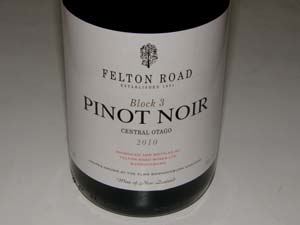 2010 Felton Road Block 3 Central Otago New Zealand Pinot Noir 14.0% alc., $69, screw cap. Imported by Wilson Daniels, St. Helena, CA. · Darkly colored in the glass. Brooding aromas of black fruits, brier, black tea, cardamom spice and leather. Reserved but interesting dark stone fruit and berry flavors with a hint of citrus in the background. A wine of character, tasting mysterious and intriguing but very young and only hinting at its ultimate potential. Silky smooth on the palate with marvelous structure and acid interplay. One of Central Otago’s benchmark wines.
2008 Tarras Vineyards Central Otago New Zealand Pinot Noir 14.5% alc., $25, screw cap. Imported by USA Wine West, Sausalito, CA. An estate wine from The Steppes Vineyard. · Moderate ruby color in the glass. Deep aromas of dark berries, wine cellar and smoky oak. California in style, with copious dark berry and cherry flavor supported by moderately firm tannins, finishing with an undertone of oak on the fruit-driven finish. Displaying to much oak influence for me at this stage. Good.
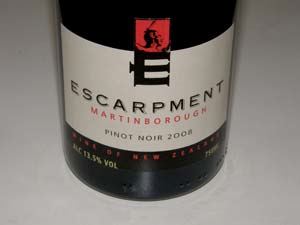 2008 Escarpment Martinborough New Zealand Pinot Noir 13.5% alc., $35. Imported by Meadowbank Estates, Alexandria, VA. The vineyard at Escarpment is planted on alluvial gravel terraces at the foot of the Aorangi Mountains. Vinified by Larry McKenna, known in New Zealand as the “Prince of Pinot.” · Moderate reddish-purple hue in the glass. Nice array of spicy red and black fruits on the expressive nose. Full-bodied and very ripe core of dark red and black fruits with complimentary oak vanillin and spice in the background, displaying a creamy mouth feel, and exhibiting a modest persistence on the finish. Very good (-).
 2008 Mountford Estate Waipara New Zealand Pinot Noir 14.0% alc., $40. Imported by Infinity Imports, Los Angeles, CA. Crafted by blind winemaker CP Lin. · Moderately light reddish-purple color in the glass. Aromas of black cherries, strawberries, sandalwood, spice and toasty oak. A bit rustic and closed, showing flavors of black cherries wrapped in supple tannins, underpinnings of tea, tar and oak, and slipping off the palate at the finish with persistent aromatic interest. Should improve over the next few years in the cellar. Very good.
Pinot BriefsRussian River Valley AVA Expansion The TTB has approved the previously proposed southern expansion of the Russian River Valley to Cotati, effective December 16, 2011. This was a very contentious proposal that was opposed by the Russian River Valley Winegrowers who have now acquiesced. The expansion was sought by E. & J. Gallo, which owns the 350-acres Two Rock Vineyard adjacent Highway 101 in Cotati. The change will add 14,000 acres to the Russian River Valley’s current 155,000 acres. For a complete summary on this decision, visit www.gpo.gov/fdsys/pkg/FR-2011-11-16/pdf/2011-29519.pdf. Wine Industry Insight, published by Lewis Purdue, has challenged Gallo's proposed boundaries for an expanded Russian River Valley AVA, claiming they violate federal regulations (see www.wineindustryinsight.com). The last word on this issue has yet to be written. I believe the large AVA needs better delineation because of its diversity, since wines from the Middle Reach, for example, are noticeably different than the wines from Green Valley or those from the Santa Rosa Plain. Steve Heimoff has pointed out seven distinct terroirs in the Russian River Valley (see www.princeofpinot.com/article/1116/) Sideways the Play Pickett, who wrote Sideways and its sequel Vertical, has now launched a social media presence including a blog at www.rexpickett.com. Around the third week of April, 2012, Sideways will be brought to the stage at Ruskin Group Theater Co., and Pickett is blogging about the play's progress before it premiers. A new documentary (My Life on Spec) is being made about the story behind Sideways: www.youtube.com/watch?v=bY3n5rK_AyY. A curious tidbit of obscure information about Sideways is that George Clooney hoped to be cast in the movie but Thomas Haden Church was chosen instead. World of Pinot Noir The WOPN has announced events for 2012. The 12th Annual World of Pinot Noir will be held at The Cliffs Resort in Shell Beach, California, Friday, March 2, and Saturday, March 3, 2012. New this year is a Vintage Burgundy Dinner being held at the Dolphin Bay Resort Friday evening. The cuisine will be prepared in collaboration by Chef Mark Peel of Campanile Restaurant in Los Angeles and Chef Brian Collins of Lido Restaurant. The Court of Master Sommeliers President, Fred Dame, will host and pour a selection of vintage and rare wines from the Court's cellar. Also new this year is the Seaside Fête which will take place on the beach at the Avila Beach Golf Resort also on Friday evening. More than 30 host wineries will be pouring to the sounds of a live band. On Saturday night, there will be Dine Around at local Central Coast restaurants with each restaurant hosting four wineries. Burgundy authority Allen Meadows will conduct a primer on the history, grapes, soils and geography of Burgundy on Saturday morning. Tickets for the two day events sell out quickly. Visit www.wopn.com for more information and to purchase tickets.
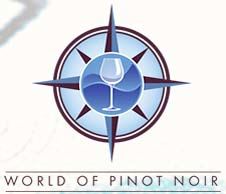 Australians Discover Brett's Genetic Blueprint Scientists at The Australian Wine Research Institute have sequenced the genome of Dekkera bruzellensis (Brettanomyces). The research was published in the November/December 2011 issue of the Wine and Viticulture Journal. The discovery could lead to better methods for controlling the yeast in wine. Launch of VinNobles A team of Master Sommeliers has founded a new wine flash site at www.vinnobles.com that puts the emphasis on well vetted, hard-to-find, iconic wines, rather than simple discounts. Beginning with weekly offers, VinNobles will offer small production wines sourced by a team headed by Master Sommelier Barrie Larvin. An early offering included a selection of highly regarded wines from Baxter Winery, a small artisan producer of Pinot Noir located in Elk near the Anderson Valley.
 Two California Pinots in Top 10 of Wine Spectator's Top 100 for 2011 The 2009 Kosta Browne Sonoma Coast Pinot Noir (5,818 cases, $52) was named the wine of the year and the 2008 Dehlinger Russian River Valley Pinot Noir (1,050 cases, $35) was named the number 5 wine. The wines were chosen out of more than 16,000 wines reviewed by the Wine Spectator in blind tastings in 2011. The criteria for inclusion in the Top 100 include quality (score), value (release price), and availability (measured by case production). The full list will be published in the December 31, 2011-January 15, 2011 issue or at www.WineSpectator.com. Oregon Wine Board Launches Wineries App To assist consumers in locating Oregon wineries on their mobile phones, the Oregon Wine Board has launched an app created by Portland-based LynkSnap, a developer of mobile websites for the wine industry. The app incorporates the Oregon Wine Map which has maps to tasting rooms, hours of operation, contact information and turn-by-turn directions. A guide to over 60 restaurants that earned “Super Cellars” awards from the Oregon Wine Press are also included (restaurants that offer exceptional selections of Oregon wines). Visit www.oregonwinemap.org where you will be directed to a mobile site to upload the app. U.S. Alcohol Consumption At a 25-Year High A recent Gallup poll shows alcohol consumption reached a new 25-year high in 2010, with 67% of Americans reporting that they drank alcoholic beverages. The all-time alcohol benchmark of 71% was set in the 1970s. According to the Washington-based Beer Institute, people in the far West and the Upper Plains states drink the most, with the deep south and Mid- Atlantic region relatively dry. New Hampshire citizens are the biggest consumers of alcoholic beverages according to the poll, with the average adult in that state doubling the national per capita average, consuming an average of 6.7 gallons of wine each in 2010. Americans consumed wine at a record rate last year, about 2.3 gallons apiece. Crushpad Offshoots in Urban San Francisco Jon Bonné wrote that two new projects have appeared in San Francisco recently that were founded by Crushpad veterans (SFGate.com, October 30, 2011). Dogpatch Wine Works was founded by Dave Gifford and Kevin Doucet, who are former Crushpad clients and investors. They are attempting to duplicate the Crushpad model on a smaller scale. Winemaker consultant for Dogpatch is Mike Zitlaff who was previously Crushpad's director of winemaking. The other project, Bluxome Street Winery, was founded by former Crushpad winemaker Chris Nelson and former Crushpad client (Connor Brennan Wines) Matthew Reidy. The partners make wine under the Bluxome Street Winery label but also host former Crushpad labels such as Furthermore and Waits-Mast Family Cellars. Visit www.dpwineworks.com and www.205.186.140.204. International Pinot Noir Tasting A large blind tasting was held in London recently featuring wines from ten of the world's major Pinot Noir producing regions. German Pinot Noir grabbed seven of the top ten spots, but the 2009 Antica Terra Willamette Valley Pinot Noir took first place. The 2008 Au Bon Climat Isabelle Santa Maria Valley Pinot Noir took third place and the 2009 Felton Road Block 5 Central Otago Pinot Noir was awarded eighth place. Consumers here in the U.S. have had almost no exposure to German Pinot Noir since just over 1% of its production is exported. Germany is the world's third largest producer of Pinot Noir and has more Pinot Noir plantings than Australia and New Zealand combined. Wine Barrel Furniture Very cool furniture handmade from reclaimed American or French oak wine barrel staves by artisans in Texas. A contoured bar stool, an outdoor swing and a bench with a comfortable bend are also offered. Visit www.uncommongoods.com.
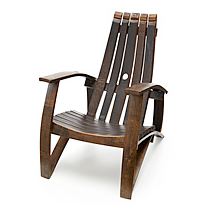 Riedel “Mamba” Decanter Wine aerates quickly through the coiled base and upright portion of this way-cool, mouth-blown lead crystal decanter, named for the world's fastest snake. The decanter was released in 2011 and is available in clear or limited edition black or green ($495 retail but available at significant discount from several online retailers). Visit www.riedel.com for other unusual decanters.
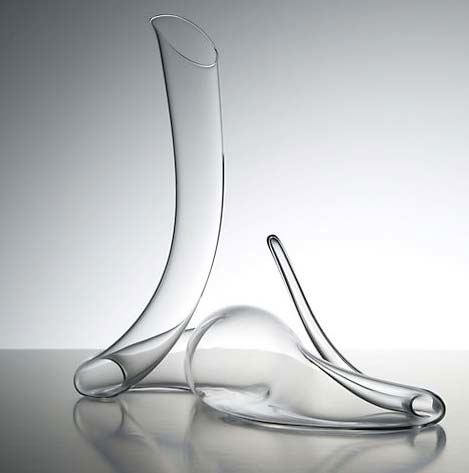 20th ¡Salud! Results 42 wineries poured at Domaine Drouhin Oregon's winery in the Dundee Hills and the 450 wine lovers in attendance bid on cases of 2010 special cuvée Oregon Pinot Noirs. Each of the 42 participating wineries produced five cases of their special cuvée. Bidding reached $2,000 per case in many instances. All five cases of Ponzi Vineyards' 2010 ¡Salud! Cuvée were sold to one bidder for $10,000. Preliminary estimates indicate the proceeds from Friday's Big Board Barrel Auction and Saturday's Dinner and Auction Gala were close to $680,000, topping last year's total. The Ponzi family was honored with the event's first-ever Founder's Award. Nancy Ponzi was one of the founders of ¡Salud!. |